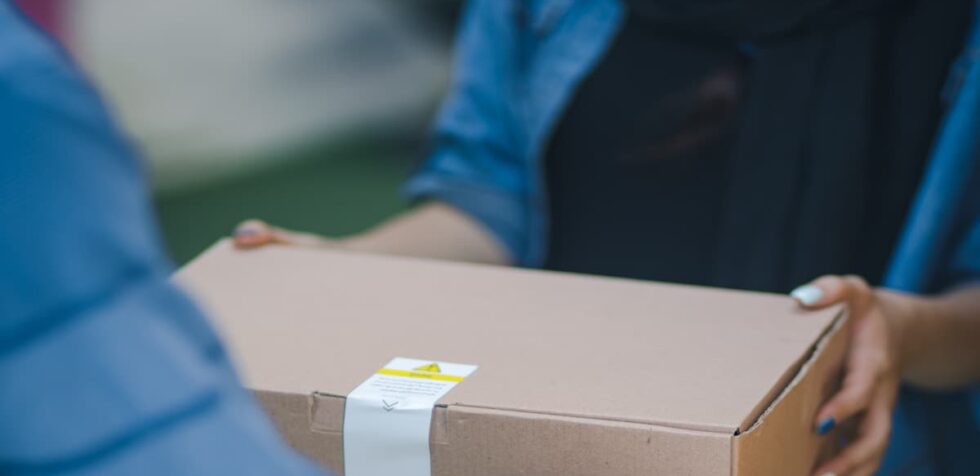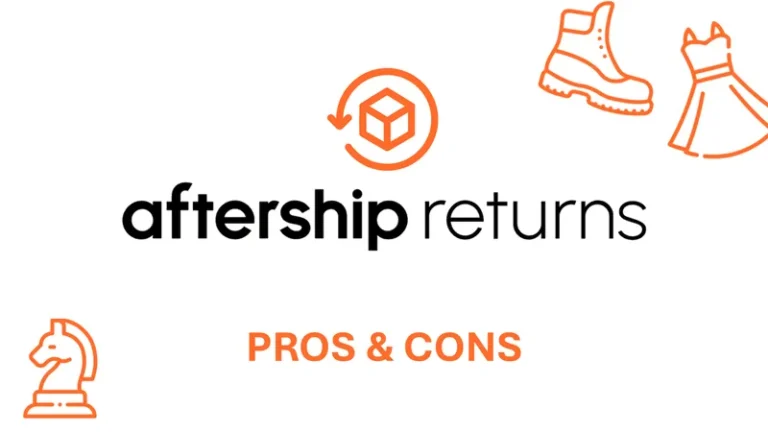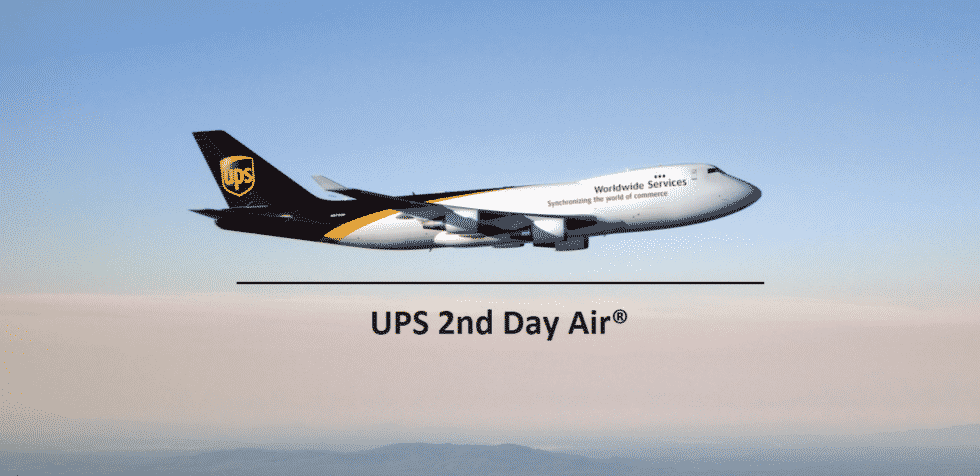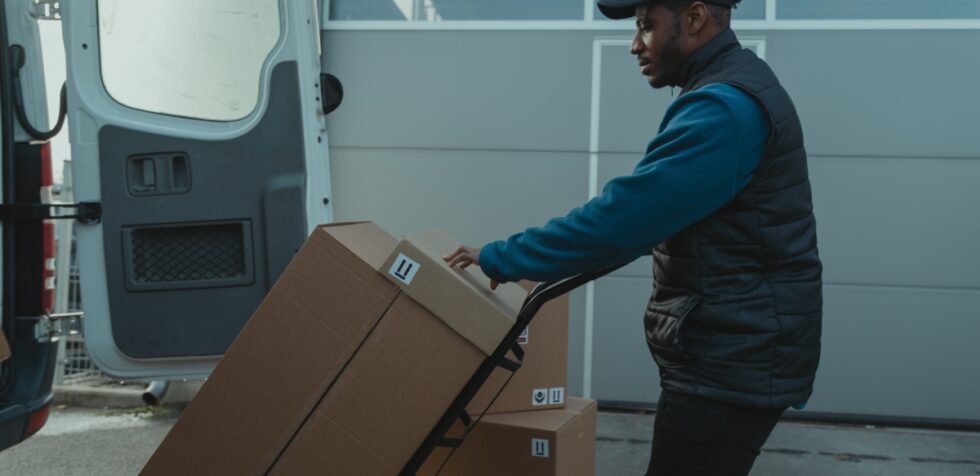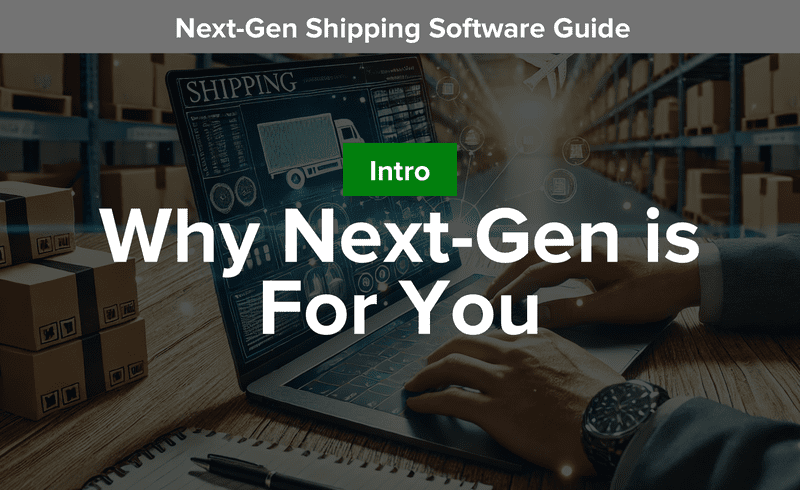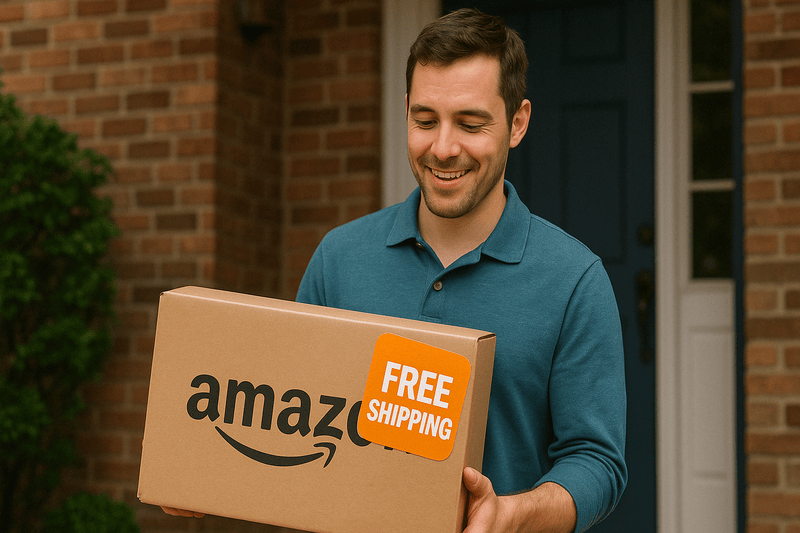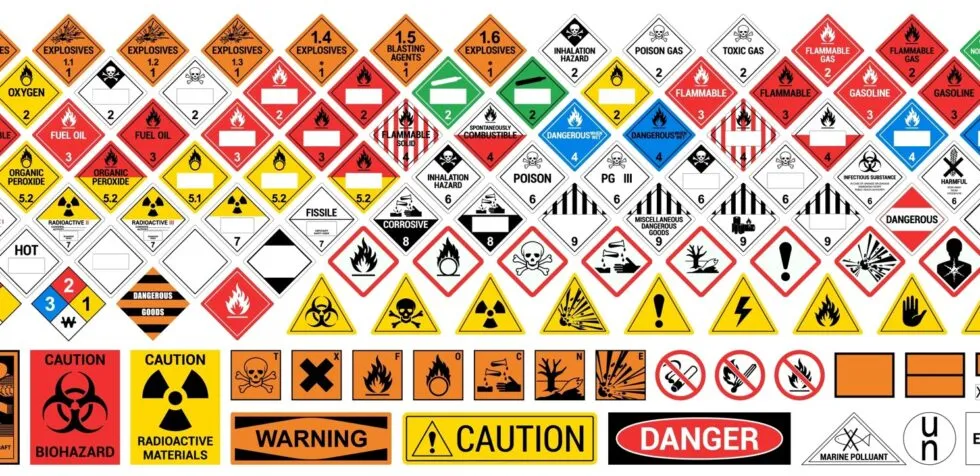Peer-to-Peer Order Fulfillment for Efficient and Affordable Shipping
In this article
 24 minutes
24 minutes
Listen to podcast here.
Podcast: ProShip ParcelCast Episode 23: What is a Peer-to-Peer Order Fulfillment Network?
Cahoot AI founder Manish Chowdhary discusses the need for distributed order fulfillment and the benefits of a peer-to-peer order fulfillment services network on a podcast. The network is a platform where eommerce brands and retailers collaborate to speed up order fulfillment and distribute inventory closer to the customer. The objective is to reduce shipping costs and improve customer experience with better and faster shipping. Distributed order fulfillment is the process of making free and fast shipping feasible and affordable for the retailer by placing inventory closer to the customer so that items can be shipped using affordable and inexpensive ground services rather than long-distance air that can be two to four times more expensive. An ecommerce brand or a retailer just needs four to five strategically located warehouses throughout the US to achieve two-day nationwide delivery guaranteed and nine warehouses to achieve one-day delivery like Amazon. Retailers have the option to build their own warehouses, lease them, sign up with multiple third party logistics (3PL) companies, or join an order fulfillment services network like Cahoot.
Justin Kramer:
Welcome to the 23rd episode of ParcelCast, what is a peer-to-peer order fulfillment services network. I’m your host, Justin Kramer, co-founder of ProShip. And with me is my special guest, Manish Chowdhary, founder of Cahoot AI, a distributed shipping software and peer-to-peer order fulfillment services network. Manish, could you take a second to introduce yourself and your company?
Manish Chowdhary:
Absolutely, Justin. Thank you for having me. First of all, my name is Manish Chowdhary, I’m the founder and CEO of Cahoot. Cahoot is the world’s first peer-to-peer order fulfillment services network. In simple words, it’s a collaboration platform where brands and retailers collaborate to speed up fulfillment and distribute inventory closer to the customer so that we reduce the shipping cost and also improve the customer experience with regards to better and faster shipping for the end consumer.
Justin Kramer:
You know what, let’s take that further. Let’s go ahead and talk about the need for distributed order fulfillment. We hear about it a lot. Can you explain to us what it is, and what our retailers’ options are nowadays?
Manish Chowdhary:
That’s a great question, Justin. Distributed order fulfillment is nothing but a methodology on making the free and fast shipping feasible and affordable for the retailer. When the consumers order stuff online, especially on sites like Amazon, they are conditioned now to expect free two-day delivery. In fact, Amazon has raised the bar on making it free one day delivery with Prime. Almost one-third of all Amazon Prime items get delivered in one business day, which is astounding. And for Amazon, business day is Monday through Sunday, so it’s not even business day anymore. And that’s the expectation that the consumers have with every ecommerce brand, every retailer. And for the brand or the retailer to make that affordably happen is bring the inventory closer to where the consumer is located so that item can be shipped using affordable, inexpensive ground service. As opposed to the long distance air, which is in on average two to four times more expensive than the economy ground shipping. So distributed order fulfillment is basically placing your inventory smartly closer to your customer so you can achieve one-day, two-day delivery without breaking the bank.
Justin Kramer:
Awesome, awesome. What kind of tools, technologies, and SLAs should we expect from something like this if I’m a mid-size retailer looking to get into something like this?
Manish Chowdhary:
You essentially have three options. One, you can go and build additional warehouses, and these are warehouses that need to exist at strategic locations. Meaning, having a warehouse in Wisconsin, for example, is not going to be very effective because that’s not where the large population lives. Of course, tri-state area, New York, New Jersey, closer to the port, that’s where a lot of the inventory from overseas come in. But also it’s a very densely populated region. And so is Southern California like Los Angeles, Long Beach, Orange County. And then of course the upper Midwest like Chicago and so on. In order to achieve two-day nationwide delivery guaranteed, a brand or a retailer needs four to five strategic warehouses throughout the nation. And if you wish to achieve one-day delivery like Amazon, you need nine warehouses strategically located in the US. And I mean strategic.
If you had a warehouse that is not in a strategic location, you’ll need many more. And so you have options. Your options are you’re going to go build these warehouses, which is very capital intensive, and you don’t know what the market is going to look like. And then also it’s getting the permits, getting all of this takes a very long time. Second option is to lease it. Again, same problem, you’ll need to enter into long-term leases because warehouse spaces in such short supply, which also is a pretty large commitment and investment. The third option is you have to go and sign up with multiple 3PLs. Because two-thirds of the 3PL, or third party logistics companies, the companies that professionally provide order fulfillment services to brands of retailers in the US are mom and pop, two-thirds. The remaining one-third are the largest of the world.
Those are the people that become the landlord to Amazon and Macy’s and others, which are largely out of reach for most mid-sized sellers. So now you need to go and negotiate and acquire these multiple 3PL with different agreements, different contracts, and then you need the technology to glue it all together because there is no [inaudible 00:05:05] to choke, so as to speak, if there’s a problem. And so all of this creates a huge burden, a huge investment for the brand or the retailer to achieve. Or the fourth option, which is really a more newer and emerging option, is to join a contract with an order fulfillment services network such as Cahoot. And there are a few others that has nationwide footprint, that has multi dozen warehouses that can achieve that delivery target, that SLA seamlessly. So that’s another option.
Justin Kramer:
You talk a lot about Amazon. Is Amazon Prime a distributed order fulfillment services network? Is that something that people are looking at at the… Or should I say, is that something that is the high end of what we’re talking about?
Manish Chowdhary:
Amazon FBA, which powers the Amazon Prime program, fulfillment by Amazon, is by far the largest distributed order fulfillment services network in the world. Not only the US. They have over 120 warehouses, not to count the sortation facilities and other cross stock facilities in the US. Amazon invested more during the pandemic in building out their fulfillment services network than they had invested in the previous 18 years. So the amount of money and resources that Amazon poured in 2020 and 2021, and also part of 2022, dwarfs the investment… Almost, they increased their footprint three times, and that’s why we heard some headlines about Amazon over building and they needed to rent out. Those were some headlines. And then trying to optimize their cost, laying off workers, closing down facilities. Amazon, like many of the other brands and retailers had overbuilt. But Amazon is by far the largest distributed order fulfillment services network in the world.
Justin Kramer:
If I’m a growing retailer and I’m looking to get into something, how is all this power that Amazon has, how does that impact me?
Manish Chowdhary:
Absolutely. Suffice to say that nearly every brand, every retailer should have an Amazon strategy. It’s hard to ignore Amazon is a sales channel when 60% of all e-commerce searches begin on Amazon, not on Google. Even whether you like Amazon or you don’t like Amazon, the reality is millions and millions of consumers go to Amazon every single day. And if they can’t find your products there, then that’s a problem, because you may be missing out on a big opportunity. A big, large segment of your target audience and population. Amazon does many things really, really well. And Amazon being the largest order fulfillment services network, but also Amazon Prime is the largest loyalty program in the world. By a long shot, you’ve got over 130 million, I don’t even have the real numbers as of now, but over 100 million subscribers that pay $120 a year to Amazon, and they get a whole host of benefits.
And the biggest benefit of it all is the free one-day, two-day delivery with no minimum. So you could literally order paperclips on Amazon, have it delivered the next day, and not pay anything for delivery because you’ve already paid into the membership program. So that is what consumers love. And while Amazon FBA is great at many things, and I can cover this if you like, I can elaborate on it. It’s not the be all and end all. It is good for many times, however, it has its own set of challenges that the retailers and ecommerce brands must be aware of.
Justin Kramer:
Let’s go ahead and ask one last question. Let’s talk about Buy With Prime. Can you tell me what the larger impact is of this program on e-commerce as a whole?
Manish Chowdhary:
That’s an excellent question, Justin. Buy With Prime launched in April of this year, this is something that has been a long time coming. As you and others listening may be familiar with, Amazon does everything at very large scale. They perfect a service first for themselves, and then they look to monetize that across the entire business ecosystem. And that’s exactly what Buy With Prime is. Buy With Prime is Amazon’s initiative to become even larger third party logistics company where Amazon will extend its Prime membership to other channels other than Amazon. Let’s say you have a website that is hosted on Shopify or on Magenta, or any website, you could install a Buy With Prime logo, a button, and you can send that inventory to Amazon FBA, and the consumer can now check out using the familiar Amazon account and get that product in one or two days.
Buy With Prime essentially extends all of the Prime benefits to websites other than Amazon. And we already seeing many, many sites that have adopted and embraced this because Amazon makes it so easy for the brands and retailers to fulfill their orders. And if brands and retailers that are heavy into FBA that sell a lot on Amazon for them, it’s a no-brainer. And so what the term or the phrase that I like to use here is, gradually and then suddenly. Up until now, consumers have been expecting the Prime benefits or one-day two-day delivery only on Amazon. But now let’s take an example. If you are a shoe retailer, and there are two of them, Acme Inc and ABC Inc. Acme Inc starts providing Buy With Prime on their website, and ABC Inc does not. Now as a consumer, I’m more likely to go check out from here, if all things being equal. So this is going to lead to this massive adoption and even acceleration of delivery expectation among consumers, because they now expect that same Prime-like experience on every channel they shop on.
Justin Kramer:
Interesting, interesting. Okay, let’s go ahead and switch topics here. Let’s talk about this new fulfillment economy and the workshare model. To the average logistics persons, companies like Gap, American Eagle, Quiet Logistics, Airterra, they were offering something very similar to what it sounds like the Cahoot network is offering. Can you talk to us a little bit about the similarities and the differences?
Manish Chowdhary:
Yeah, this is a new development that’s happening in the e-commerce and retail logistics space. Cahoot was of course the pioneer in peer-to-peer collaboration. And essentially, Cahoot acts as a neutral third party where there are plenty of merchants. There are about three million online merchants in the US compared to about 20,000 3PL companies. So these are third party logistics companies that will provide fulfillment as a service. By sheer comparison, and the analogy I’d like to make is Airbnb versus Hilton. There are many more homes with spare bedroom and a spare wing than there are hotel rooms in the US. Rather than building more warehouses where rooms are going empty, or the space is going empty in these millions of warehouses. Cahoot is aiming to bring these surplus capacity into the market so as to reduce the cost and improve utilization. This goes hand in hand with trying to make the most or more of what resources we already have, as opposed to trying to spend more capital expense, which essentially increases the cost one way or the other for the brand or the retailer.
What Cahoot has done is created a network of very highly qualified, highly vetted brands and retailers that do a spectacular job of order fulfillment for themselves, but that have extra capacity, let’s say 5, 10, 50, 20, 100,000 square feet of excess capacity. For the very first time, they can join the Cahoot network and monetize that excess capacity by fulfilling orders for other brands. And Cahoot acts as the independent governing body with the technology, the software, so that it is not a distraction for them. It is simple, it’s easy, and it’s effective. And it also gives the seller, the brand, our customer, the assurance that we are holding everybody accountable. And there is harmony and there’s SLA being delivered. And so it’s very exciting to see other retailers like Gap and American Eagle finally come to embrace the model that we’ve been preaching for a long time.
And the one difference, there’s not a lot we know about these models because there’s not a lot published on them because it’s still a closed system. But one thing, suffice to say that most brands, most retailers would prefer an independent body to audit the service provider. And that’s the advantage that Cahoot provides, because Cahoot is not representing just the buyer or just the warehouse. Cahoot is the independent body that keeps everybody organized and creates a common rule and level playing field for all the participants, and provides the visibility. That’s the one thing that I personally believe that having that independent body is a very crucial, it provides trust, it provides visibility, and it provides the assurance and it provides accountability. We would very much welcome Gap and American Eagle to join Cahoot so that we can give that assurance to small and large size retailers.
Justin Kramer:
And it also sounds like if I’m a Cahoot member I can now more easily expand to those five to nine distribution points so I can have two-day or next day delivery for most of the country.
Manish Chowdhary:
Absolutely. The whole idea is, how do we create a Prime-like network and Amazon FBA-like network without the challenges that FBA faces? FBA is great at many things, but it does not… Even to this day, many, many sellers could not get their inventory into FBA on time for the holidays. They had limits placed on their account that they could only send so many units, and they rely on other networks like Cahoot to fulfill even their orders on Amazon. While Amazon is growing, they’re launching all these services, it has its own set of challenges. Amazon is not geared for all things to everyone at all time because Amazon only wants fast moving inventory. But from a retailer’s perspective, they also need to fulfill their wholesale orders, they need to fulfill orders from Walmart. Which, you cannot use FBA to fulfill, it’s against Walmart’s rules and policies that you cannot have a Amazon branded box being delivered to the Walmart customer that bought the item on the Walmart marketplace. And rightfully so.
Justin Kramer:
Let’s switch over to some other networks that sound like they’re similar. I know that the carriers, some of the airlines, and other particular merchant groups have some stuff similar to this. Can you talk about that and compare and contrast a little bit for us?
Manish Chowdhary:
Absolutely, Justin. The idea of coopetition has existed for a long time, where seemingly retailers may consider themselves to be competitors, but not necessarily. Because a retailer who has a warehouse in New York is really not competing with the retailer of a different product with a warehouse in California. It is in their interest to collaborate so that both of them win because they are not competing. And so we know of many, many very successful networks of this kind, going back to the, let’s take airline co-share. Not every airline flies to Maui, Hawaii. But if you want to get from Chicago to Maui, you might have to go from Chicago to Dallas, or Chicago to LA, and then LA to Maui, for example. For example, Delta, as part of the Sky team has many other airlines that share the code and so on.
So this is very, very common. It makes the airlines be profitable and able to service the needs of the customer. Because ultimately about getting to Maui, not about how many websites and tickets you need to buy separately. Likewise, we also know for examples in the flower delivery space, the FTD. Which is if I want to send flowers, I’m in New York and I need to send flowers to my sister-in-law in Palo Alto in California. Of course the local florist is not going to be the one delivering, but as part of the network, they can easily arrange for someone locally to deliver. And we’ve always known about the workshare model in the carrier space, which we know that USPS has long had workshare programs with UPS, FedEx. Programs like UPS Mail Innovation, FedEx Smart Post. Cahoot is simply extending the same concept to the world of order fulfillment and warehouses. Because ultimately, when there is greater utilization of resources that we have, that leads to a better experience and lower cost for all the participants involved.
Justin Kramer:
Very interesting, very interesting. Manish, can you tell our audience, what is a peer-to-peer order fulfillment services network?
Manish Chowdhary:
A peer-to-peer order fulfillment services network is a large scale nationwide network of warehouses that allows a ecommerce brand or retailer to compete at the level of Amazon Prime, which is one-day, two-day free delivery. Every brand, every retailer should be offering the service on all channels that they serve. And they can easily achieve that by joining Cahoot, because Cahoot has the number of locations and the diversity to place the inventory closer to the customer so that the items can be delivered inexpensively and fast without incurring additional cost. And on the fulfillment provider side, if you are a brand or retailer that has, owns, or operates a warehouse and has spare capacity, be it 5,000 square feet or 50,000 square feet, and you would like to monetize that excess capacity, excess space, please come check out Cahoot.ai and fill out a contact us form so you can apply to become a Cahoot fulfillment partner.
And we would love to speak with you, because we would love to add more warehouses to our network. So you benefit not just by providing faster and cheaper delivery to your customers, but also by monetizing your spare capacity so you make more out of your existing fixed investments.
Justin Kramer:
Excellent. Let’s go ahead and let’s move on to the changing base of reverse logistics. Let’s face it, over the last several years we’ve seen companies try to return everything. We’ve seen companies try to return nothing, just ask the customer to throw it away. But one way or another, we all know that reverse logistics is a huge part of the customer satisfaction story when it comes to e-commerce. Can you tell us a little bit more about it?
Manish Chowdhary:
Yes, Justin, this is of course when e-commerce was only 1% of total retail. Brands and retailers were motivating customers to shop online because it was, so-called it was a channel shift. It was giving customers more self-service option. It is akin to motivating customers in the grocery stores to do self-checkout now, you try to encourage them. And of course consumers got very, very much used to… And in order to do that, they offered free shipping on the way in, and they also offered free returns. Because it was one of those taking away the friction in online shopping that if you didn’t like something you could return it for free and no questions asked. Of course, that was intended to be simply an encouragement for the consumers to shop online, and which quickly changed into the concept of showrooming. It’s essentially consumers, especially in the apparel space, buying three items with the intention of only keeping one.
And because items are free to return, you could simply return it back. This went on for over a decade now, and sites like Amazon, or when the products are rather inexpensive, it costs more to ship them back and process that item that is returned than to let the customer keep the item. However, we are entering a new phase and we can see that with the brands like Zara and Gap and others that are cramping down and they’re saying enough is enough. There have been chronic people that constantly return items that is playing a havoc on the profitability of these companies. Essentially, the movement has already started, and some of the top brands and retailers have taken a lead that now if you want to return the item back to Zara, you’re going to have to pay a return fee, or you have to pay cover the cost of shipping. I think they’re going through a natural leveling of consumer expectations. And I don’t expect free returns to loss for most items in the next couple of years, that’s going to change quite dramatically.
Justin Kramer:
That will be very interesting, no more free returns. I know companies like Zappos, that’s exactly how they made their name in the market was you could bracket, by the size above, the size below, and get to choose what you wanted. Very interesting. Are you seeing this anywhere yet, or is this an expected 2023 trend?
Manish Chowdhary:
No, we heard from folks like Zara and others that they are already beginning to charge for returns. This is already in play now. It’s just not an idea or a thought. And of course, it takes a little bit of the top leaders to take a position and then others will follow. I expect of course, Amazon being the big bellwether, it remains to be seen what Amazon Prime is going to do because I think they constantly set the bar, so we’ll see. But also from a sustainability standpoint, Justin, this is not just about the cost. But if we encourage people to return, we are adding more carbon emissions. I think there will be brands that would take a stance that it is not just good for e-commerce, but it’s good for the planet. I do expect that the scales to be tilting in this direction not too long from now.
Justin Kramer:
Yeah. And I have to say, I think you’re right. Because you do see even Amazon in their partnership with stores like Kohl’s wanting you to just take it to that store where you’re already going to be, rather than putting it in its own, usually oversized box, sticking a label on it, and having it take up space on a truck or a trailer somewhere. All right, let’s move on to final thoughts. Question for you, is there any takeaways you want to make sure that our listeners have heard today and that they action against?
Manish Chowdhary:
My recommendation to all the listeners is that free and fast delivery, free one-day, two-day delivery is here to stay. And it’s not just on Amazon. Any channel that you’re selling on, you’ve got to embrace distributed order fulfillment. How you do it, there are four options as we covered earlier in the podcast. It is crucial in order to maintain your competitive positioning and also maintaining the consumer expectation, which is changing very rapidly. And especially with Buy With Prime program, which is going to launch, or rather, get rolled out quite aggressively in 2023. You want to get ahead of that. I would very strongly encourage to get a head start in 2023 and test this out, and make sure you have this systems and technology and your fulfillment and your providers figured out. And if you have spare capacity, why not put that to good use? Energy costs are all time high. So if you can make an extra income from your existing investments, that’s good for you, but it’s also good for the planet.
Justin Kramer:
Agreed. The one thing I took away from this, I’m going to try to narrow it down to a sentence. In the past we’ve always had buy, lease, or outsource. Right? But with a peer-to-peer network, we now have a fourth option. We can buy, we can lease, we can outsource two or 3PL, or we can collaborate with other like retailers. Is that correct?
Manish Chowdhary:
That is absolutely correct, Justin. I think we are all in this together, and that’s why our tagline, Cahoot’s tagline is Power of Many. It’s brands of retailers helping each other.
Justin Kramer:
All right. If you’d like to learn more, please visit us at proship.com or cahoot.ai. Thank you for joining us today. If you have any questions, just a reminder, you can reach ProShip at sales@proshipinc.com, or (800)-353-7774. We hope you join us for our next ParcelCast. Thank you for tuning in.
Offer 1-day and 2-day shipping at ground rates or less.
Related Blog Posts
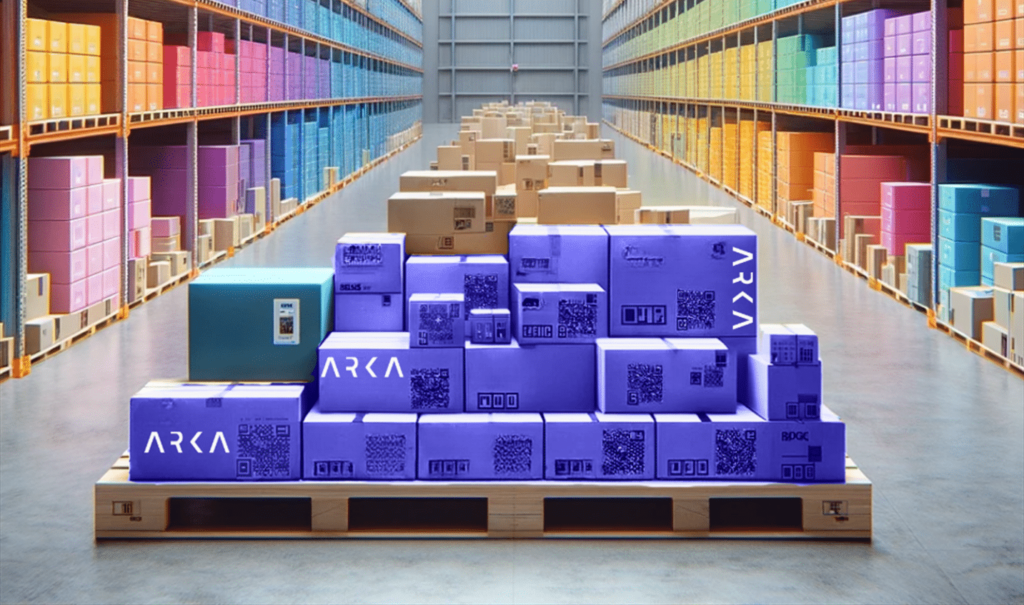
Packaging Design That Will Make Fulfillment Easy and Cut Costs
E-commerce Revolution with Strategic Packaging Solutions Like anyone in the e-commerce world, small business owners are always looking for ways to streamline their operations and

Preparing for Peak Holiday Shipping Season [Guide for 3PLs]
The peak holiday season is the most critical time for e-commerce businesses due to spikes in order volumes, high consumer expectations, and operational complexities.

2025 Updates to Amazon Referral and FBA Fees
Amazon’s decision to freeze referral and Fulfillment by Amazon (FBA) fees for 2025 in the US has been met with mixed reactions, and a closer look suggests that this move may be more self-serving than it appears on the surface.

Turn Returns Into New Revenue

Buy with Prime Extends FBA to DTC Ecommerce
In this article
 8 minutes
8 minutes
This past Thursday, April 21st, Amazon launched a new service: Buy with Prime. For a fee, the service will let third-party ecommerce merchants use Amazon’s huge distribution network to fulfill orders on their own sites. It’s Amazon fulfillment for DTC sites.
On top of that, Buy with Prime web sites will be allowed to put the Prime badge on their websites next to items eligible for free 2-day and 3-day shipping (which will be most items), helping boost their conversion.
And finally, Amazon Prime members that purchase from third party sites that use Buy with Prime will have their payment and shipping information pre-loaded in the checkout window, further smoothing the conversion process and decreasing cart abandonment.
In this article, we’ll share what we know so far about the service and dive into pros, cons, and fulfillment service alternatives for sellers.
Who Benefits from Buy with Prime?
Amazon is targeting Buy with Prime firmly at online sellers with DTC stores. While Amazon previously offered its multi-channel fulfillment service to DTC sellers, this new offer seems in many ways to be a direct replacement, and we anticipate that they’ll slowly phase out Amazon MCF in favor of Buy with Prime.
While Buy with Prime is currently invite-only, Amazon’s new website for the program clearly demonstrates who they think will benefit most from using it. As you can see in the below screenshot, they’re positioning it as a way that DTC sellers can grow their business.
Buy with Prime asserts: if you’re a DTC seller, you can stop worrying about fulfillment and delight customers with fast and free shipping by signing up with us.
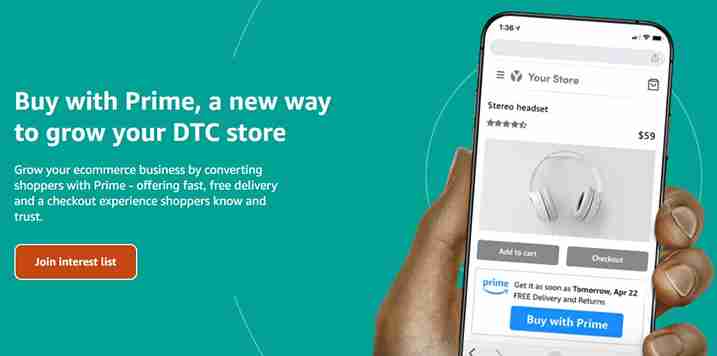
It stands to reason that this will become and remain Amazon’s fulfillment solution for direct-to-consumer online sellers, but that it likely won’t grow further. It would be remarkable if other marketplaces like Walmart or Target integrated with Buy with Prime (at least for the time being), and we’ll be very interested to see whether a critical mass of Shopify or BigCommerce sellers jump over to Amazon’s new service.
Shopify fulfillment network recently significantly drew back its ambitions, but in its place, Shopify has quickly pivoted to talks to buy a rival fulfillment service. If Shopify makes such a large investment in a fulfillment network of its own, it likely will want to shut Amazon out of its user base in favor of its own solution. As it stands, it’s an open question as to whether Shopify sellers will be able to use Buy with Prime.
We’ll keep a close eye as the situation develops, because multi-channel sellers know how painful it can be to have to manage multiple fulfillment solutions. Amazon is making a big play to extend FBA across more of the ecommerce landscape, but its competition isn’t standing still.
What Are the Drawbacks?
Buy with Prime promises to solve checkout and fulfillment for DTC merchants, but convenience will come at a price. Sellers trying to make it on their own or pursuing a multichannel ecommerce strategy enjoy significant benefits from their strategic distance from the big marketplaces, and implementing Buy with Prime will blur those lines and risk losing more than you gain.
Amazon Owns Your Customer
If Amazon gets their logo on your checkout process, and the customer converts because they feel more comfortable with Amazon, who really owns the customer? Or worse, will the customer even stay on your site?
Many DTC sellers have built brands and struck out on their own because they want to get away from Amazon and its questionable business practices. By owning their customer, they build long-term relationships that lead to repeat purchases and realize significant long-term customer value, the basis of sustainable profitability.
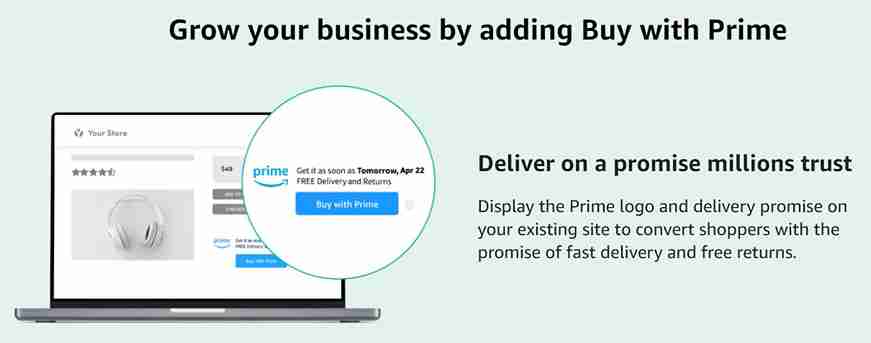
Source: buywithprime.amazon.com, 4/26/22
By bringing Amazon back into the mix, DTC sellers risk all of their hard work in developing a unique relationship with their customers. Fast and free shipping does boost conversion, so you may see a boost from new customers – but with Amazon’s logo doing the heavy lifting, you’re also giving customers the idea to head over to Amazon to price check and look at competitive offers.
Well over half of online product searches already start on Amazon. Do you really want to give shoppers the idea to pop over to the ecommerce giant after you’ve done all the hard work advertising to get them onto your site?
Pay Hefty Amazon Fees
In Q4 2021, Amazon made $30.3 billion from third-party seller services, which includes commissions, fulfillment, and shipping fees. While we don’t yet know the full fee structure of Buy with Prime, all indicators point to the company trying to turn this into the next Amazon Web Services. After all, in recent years Amazon has continued to lose money on its core retail business, while it makes up for it with huge profits from AWS and its advertising business.
AWS famously started as an internal service to run Amazon’s business before they productized it and started selling it to the world at large. Amazon FBA is now following the same exact path: it started as a way for Amazon to fulfill their own orders, then they extended it to third-party sellers, and now they’re expanding to DTC merchants. We anticipate that they’re targeting significant margins with this new business – perhaps they could even rival AWS’ 60%+ operating margin.
With this model, DTC merchants will feel the crunch in their own profitability. In exchange for increased conversion thanks to the Amazon Prime badge, they’ll realize lower margins. If the extra revenue doesn’t flow through to the bottom line, is the service worth it?
Competes with Your FBA Inventory Limits
Finally, if you’re a multichannel seller trying to win on Amazon and on a DTC site, you don’t get two separate inventory limits. All of your FBA and Buy with Prime inventory goes into one pool, and where an order is placed doesn’t make a difference.
While this is helpful in its simplicity, it’s a big potential challenge because Amazon is notorious for imposing too-strict FBA inventory limits and for long receiving delays. With all of your eggs in the FBA basket, you make yourself extremely vulnerable to a self-serving change in inventory limits or one of FBA’s routine weeks or months-long receiving delays.

The best fulfillment practice for Amazon-only sellers is to have an FBA alternative for the many times when FBA falls flat, and that will be doubly true for Buy with Prime users. If you’re selling on Amazon and on a DTC site, and a receiving delay knocks your best seller out of stock, that now doesn’t just kill your Amazon sales rank – it also kills your DTC store’s SEO and paid advertising efforts!
Though Amazon is positioning Buy with Prime as a holistic solution for DTC sellers, we assert that relying wholly on Amazon FBA would be a fatal mistake for your business.
The Buy with Amazon Prime Alternative: Cahoot
Cahoot has created a robust
If Buy with Prime’s promise of a simple multi-channel answer to fulfillment appeals to you, contact us in addition to sending in your application to Amazon.
Cahoot is the next generation of tech-enabled fulfillment networks. Unlike other networks that are collections of 3PLs, Cahoot’s innovative approach empowers merchants across the country to fulfill orders for one another. Our peer-to-peer network is a collective of highly vetted eCommerce retailers who offer up excess warehouse space and resources to provide high-quality order fulfillment to other merchants. Since they fulfill their own DTC orders, they know how important top-notch fulfillment is, and they put the same care and energy into your orders as they do for their own.
As a result, costs are typically lower than what you get with a traditional 3PL fulfillment company, yet service levels are higher. With a P2P network, multi-channel fulfillment with nationwide 1-day and 2-day delivery at economy shipping rates is the norm. Merchants can use the network solely for outsourced fulfillment – similar to FBA, or they can choose to fulfill orders for other merchants and offset some of their own outsourced fulfillment costs.
Offer 1-day and 2-day shipping at ground rates or less.
Recent Blog Posts

Packaging Design That Will Make Fulfillment Easy and Cut Costs
E-commerce Revolution with Strategic Packaging Solutions Like anyone in the e-commerce world, small business owners are always looking for ways to streamline their operations and

USPS Hazmat Shipping Guidelines – How to Ship Fast While Staying Compliant
Hazardous Materials What is a Hazardous Material? What Items Are HAZMAT? Classes of HAZMAT Items What Classes Can Ship on Various USPS Services? What Changes
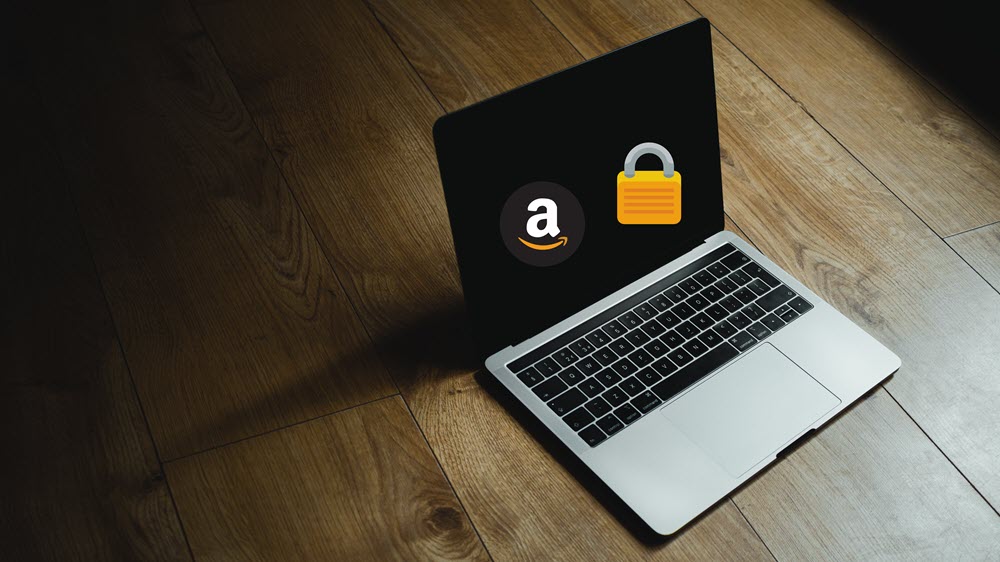
Protect Your Amazon Listings from Search Suppression, Hijackers, and Stockouts
Amazon is a competitive platform. You need to have a quality product, excellent listing content, and plenty of reviews to catch the attention of busy

Turn Returns Into New Revenue

The Ecommerce Merchant’s Guide to UPS 2nd Day Air
UPS offers a host of services to ensure that your packages are delivered quickly to customers. Small improvements in which service you pick can have a big impact on customer experience and profitability, so in this guide we’ll walk you through your options and how to make the right choice for your business.
What is UPS 2nd Day Air?
As customer expectations for fast shipping increase, services like UPS 2nd Day Air gain prominence. UPS 2nd Day Air is an alternative for businesses that require fast, but not overnight delivery. It’s simple – slow delivery speeds blunt online store growth because products with slow shipping are added to carts less frequently, and their carts are abandoned more often than products that ship quickly. A 2023 Hanover Research study found that 86% of online shoppers see 2- to 3-day delivery as the baseline, and 63% say they would switch retailers if they could not receive their items within this timeframe.
UPS 2nd Day Air is one of a few expedited shipping options from UPS, and they describe it as their “economical option for shipments that do not need overnight service”. Designed to meet domestic shipping needs across the continental United States and Puerto Rico, 2nd Day Air ensures that a package will arrive at its destination in two business days but the ‘type’ of 2nd Day Air you choose will affect the delivery time.
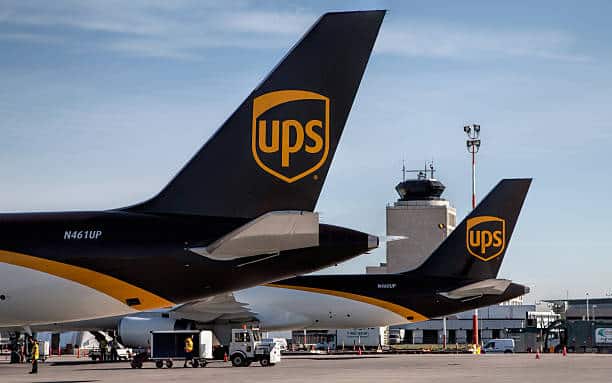
UPS 2nd Day Air provides day definite delivery; ensuring packages arrive within a specified timeframe. But there are two different types of 2nd Day service – standard service and AM. When someone absolutely needs an item first thing in the morning, you need to spring for the much more expensive 2nd Day Air AM. Without 2nd Day Air AM, UPS only guarantees an end-of-day delivery time, which can of course stretch late into the night.
In addition to 2nd Day Air, UPS also offers 1-day and 3-day expedited services. The 1-day service is called UPS Next Day Air, and as you can imagine the 3-day service is called UPS 3 Day Select.
Benefits of Using UPS 2nd Day Air
UPS 2nd Day Air is a popular shipping option for businesses that need to deliver products quickly and efficiently. Here are some benefits of using UPS 2nd Day Air:
- Fast Delivery: UPS 2nd Day Air guarantees delivery by the end of the second business day, making it an ideal option for businesses that need to deliver products quickly. This ensures that your customers receive their orders promptly, enhancing customer satisfaction and loyalty.
- Cost-Effective: Compared to overnight shipping, UPS 2nd Day Air is a more cost-effective option. It allows businesses to save on shipping costs while still providing expedited delivery. This balance between speed and cost can be crucial for maintaining profitability in a competitive market.
- Reliable: With UPS 2nd Day Air, you get the peace of mind that comes with guaranteed delivery. UPS guarantees delivery within two business days, ensuring that your packages arrive on time and reducing the risk of delays that could impact your business operations.
- Flexible: UPS 2nd Day Air offers a range of shipping options to meet different needs. Whether you require morning delivery, afternoon delivery, or residential delivery, UPS has you covered. This flexibility allows businesses to cater to various customer preferences and special delivery instructions, enhancing the overall shopping experience.
UPS 2nd Day Air Delivery Times
UPS 2nd Day Air delivery times vary depending on the destination and the time of day the package is shipped. Here are some general guidelines for UPS 2nd Day Air delivery times:
- Business Days: UPS 2nd Day Air delivery times are based on business days, which are Monday through Friday and do not count the date of shipment. This means that packages shipped on a Friday will typically be delivered by the end of the day on the following Tuesday.
- Delivery Begins: Delivery begins at 10:00 am, and the first packages are typically received by 10:30 am. This early start ensures that businesses can receive their shipments promptly and begin processing them without delay.
- Afternoon Delivery: For those who prefer later delivery times, UPS 2nd Day Air offers afternoon delivery, with packages typically arriving by 4:30 pm. This option is ideal for businesses that operate later in the day or for customers who are not available in the morning.
- Residential Delivery: UPS 2nd Day Air also caters to residential delivery needs, with packages typically arriving by 7:00 pm. This ensures that customers who are not home during the day can still receive their packages in the evening.
Overall, UPS 2nd Day Air is a reliable and cost-effective shipping option that offers fast delivery times and flexible shipping options. Whether you need to meet tight deadlines or provide convenient delivery times for your customers, UPS 2nd Day Air has the solutions to meet your needs.
How Much Does Shipping UPS 2nd Day Air Cost?
Cahoot’s internal shipping metrics show that UPS 2nd Day doesn’t come cheap – in fact, we observe that it’s often roughly two times as expensive as UPS Ground.
If you’re used to paying $8 or $9 to ship your packages via Ground and seeing them take a week to deliver, 2-day delivery is going to cost you somewhere in the upper $10 dollar range. In the hyper-competitive ecommerce world, an extra $5-10 in shipping costs can often be the difference between making and losing money on an order.
UPS 2nd Day Air AM balloons the cost of shipping far beyond the standard version of 2-day. Our data shows that the AM option nearly doubles the cost of standard – so it often comes in at nearly 4 times more expensive than UPS Ground. To us, the small added benefit of an early delivery won’t often justify the large added cost.
How to Ship Fast Without UPS 2nd Day Air
To quickly recap – customers expect fast shipping, so you need to offer it to boost growth. However, fast shipping is prohibitively expensive. If you’re like the vast majority of ecommerce merchants and can’t eat $10 extra in shipping on every single item, you need a better way.
The solution to this riddle is to ensure that you always have inventory close to the customer so that UPS Ground delivers in 1- to 2-days without the extra cost of 2nd Day Air – many call this a “distributed fulfillment strategy”. Typically, this means ensuring that you never ship farther than Zone 4, and it requires ~4 fulfillment locations strategically placed throughout the United States. This simple principle, though, is anything but simple in execution.
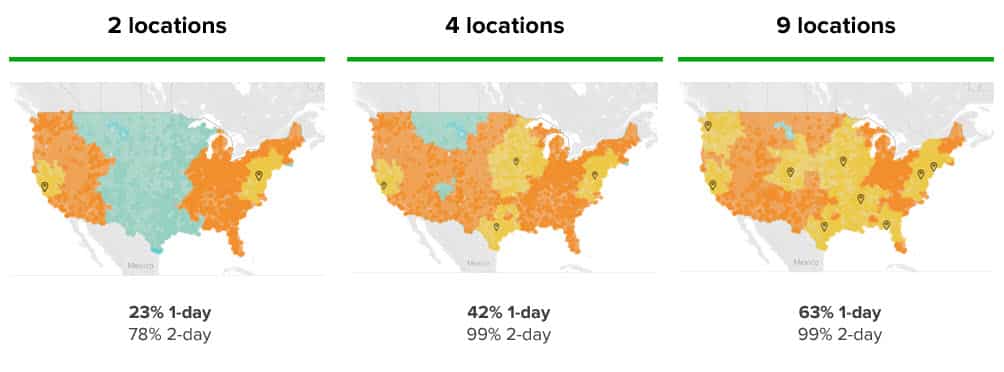
Here’s the three ways that merchants can adopt a distributed fulfillment strategy:
- Open Multiple Fulfillment Centers: merchants can open multiple US fulfillment centers and manage the four walls themselves. While having control may seem appealing, there’s never been a worse time to try to stand up merchant-operated fulfillment. Warehouse rents are hitting record highs, and if you can even find people to work for you, you’ll have to pay them $29.00 per hour to compete with Amazon’s rates. This strategy is also time-consuming and risky – you’ll spend countless managerial hours on operations instead of selling, and you’ll have to tie up significant capital.
- Marketplace Fulfillment Services: Amazon and Walmart offer their own in-house fulfillment networks; Amazon FBA and Walmart Fulfillment Services, for sellers on their platform. They enable fast shipping nationwide, and crucially, they allow vendors to place Prime Badges and Walmart TwoDay tags on their listings to boost visibility and conversion. While attractive, these solutions come with significant drawbacks. They’re designed for small products, so FBA is much more expensive for large items, while Walmart doesn’t accept them at all. Additionally, they’ll only solve your fulfillment needs for the marketplace itself. Amazon FBA’s multi-channel solution, Amazon MCF, is significantly more expensive than FBA, while WFS only works for Walmart orders.

- Third-Party Logistics Companies (3PLs): Your last option is to outsource fulfillment to one 3PL with national fulfillment services, or to multiple single-location 3PLs. The best 3PLs will have 10 or more locations across the United States, so they can strategically place your inventory right near your customer base. Modern 3PLs designed for ecommerce also have built native integrations with all major marketplaces and shopping carts, so you can use one provider for all of your fulfillment needs. Fulfillment costs will vary between 3PLs, though, and not all of them can meet the strict SLAs needed to win the Buy Box on every marketplace. Be sure to use something like a 3PL request for proposal (RFP) template to get an apples to apples comparison.
Cahoot Enables 2-day Shipping at Ground Rates
Cahoot’s nationwide network of over twenty warehouses provides affordable national ecommerce order fulfillment for ecommerce merchants. Thanks to our dense network, we’ll strategically distribute your inventory so that you reach 99% of the country in 2 days but always pay low ground rates.
Unlike other providers, Cahoot has the flexibility to upgrade existing merchant-owned warehouses (if you have them). We’ll analyze your existing network and customer base, then add a few locations of our own to seamlessly extend your network into a nationwide footprint. With this approach, you can continue to get value out of your existing assets while delighting your customers and your bottom line with affordable fast shipping.
Getting started with Cahoot is fast and easy – with pre-built integrations for major ecommerce channels like Amazon, Walmart, Shopify, and BigCommerce, we can get merchants started in as little time as it takes to send us your inventory.
Talk to one of our experts today and explore how we can be the key that unlocks the next level of your profitable ecommerce growth.
Frequently Asked Questions
What is UPS 2nd Day Air?
UPS 2nd Day Air is a shipping service that guarantees delivery within two business days.
What Does 2 Business Days Mean?
UPS counts standard week days as a business day. This means a package picked up on Friday will deliver by Tuesday end of day.
What is the Package Weight or Size Limit?
UPS 2nd Day Air shipments must be 150 lbs or less. Packages should be no more than 119 in long or 165 in combined length plus girth dimensions.
Does UPS 2nd Day Air offer Saturday Delivery?
UPS 2nd Day Air offers Saturday delivery if packages are picked up on Thursday by UPS.

Turn Returns Into New Revenue

The Best Way to Ship Heavy Items: How to Maximize Your Profit
If you’re shipping large items, then you know the pain of high storage, handling, fulfillment, and especially shipping costs eating up your margin. While you’ll always pay more to ship a chair than a pen, you shouldn’t resign yourself to eating sky-high rates. With higher shipping costs come larger opportunities to save money; cutting a few dollars of cost off of each order goes straight to your bottom line.
In this article, we’ll cover three of the top ways that you can reduce your cost while shipping heavy and/or large items. Implement them and watch your profit jump and headaches melt away!
Understanding Heavy Item Shipping
Heavy item shipping refers to the transportation of goods that exceed standard weight and size limits. These items require specialized handling, equipment, and logistics to ensure safe and efficient delivery. Whether you’re shipping industrial machinery, medical equipment, or large furniture pieces, understanding the nuances of heavy item shipping is crucial for minimizing costs and maximizing efficiency.
Heavy vs Large Packages
First, we need to make a distinction between heavy and large items. Often large items are heavy, and heavy items are large, but that’s not always the case. When you ship heavy packages, it’s crucial to understand the specific rules, limitations, and pricing options of different carriers to ensure shipping cost-effectiveness and compliance. Improper shipping and handling can also include additional surcharges, double penalizing shipping heavy items. Shipping carriers have specific guidelines and weight thresholds that classify items as heavy, and understanding these definitions can help you choose the right shipping method and carrier.
Definition of Heavy Items in Shipping
Carriers define packages as Heavy if the package weighs more than their normal weight range. For example, UPS charges additional fees for packages weighing more than 70 lbs (31.75 kg), and their maximum allowed parcel weight is 150 lbs.
Definition of Large Items in Shipping
Carriers define packages as Large if the package’s size is more than their normal allowed size range. For example, FedEx’s Large package size starts at a girth greater than 130 inches, and their maximum allowed package length + girth is 165 inches.
Types of Heavy Items
Heavy items typically include furniture, machinery, tools, and other items made of wood or metal. These are typically bulky goods that require special handling and care.
Importance of Proper Shipping for Heavy Items
Proper shipping of heavy items is crucial to ensure safe and efficient delivery. Improper handling and transportation can result in damage to the goods, injury to handlers, and increased shipping costs. Choosing a reliable shipping carrier that specializes in heavy item shipping and follows strict safety protocols is essential. By investing in proper packaging, using heavy-duty packing tape, and selecting the right shipping method, you can minimize risks and ensure your heavy items reach their destination in perfect condition.
Freight (LTL) Shipping Options
Freight shipping is a cost-effective way to transport heavy items over long distances. There are several freight shipping options available, each offering unique benefits and services tailored to meet the needs of shipping large and heavy items. For items that are too heavy to ship via parcel, freight shipping is the best option.
Overview of Freight Shipping Services
Freight shipping services offer a range of benefits, including:
- Cost-effectiveness: Freight shipping is often cheaper than parcel shipping for heavy items. By consolidating shipments and using specialized equipment, freight carriers can offer competitive rates for transporting large and heavy items.
- Flexibility: Freight shipping services can accommodate a wide range of goods, including oversized and heavy items. Whether you’re shipping machinery, equipment, or furniture, freight carriers have the expertise and resources to handle your shipment.
- Reliability: Freight shipping services provide tracking and monitoring to ensure safe and efficient delivery. With advanced logistics and real-time tracking, you can stay informed about the status of your shipment and ensure it arrives on time.
Some popular freight shipping services include:
- DHL Freight: Offers a range of freight shipping services, including ocean freight and air freight. DHL Freight specializes in international shipping and provides comprehensive solutions for transporting heavy items across borders.
- UPS Freight: Provides freight shipping services for heavy items, including machinery and equipment. UPS Freight offers a variety of shipping options, including LTL (less-than-truckload) and FTL (full-truckload) services, to meet your specific needs.
- FedEx Freight: Offers freight shipping services for heavy items, including furniture and oversized goods. FedEx Freight provides reliable and efficient shipping solutions, with options for expedited and standard delivery.
When shipping heavy items, it is essential to choose a reliable freight shipping service that meets your specific needs and budget. Be sure to compare shipping rates, weight limits, and express services to find the best option for your heavy item shipping needs. By selecting the right freight carrier, you can ensure your heavy items are transported safely and cost-effectively.
Distribute Inventory to Reduce Shipping Zones
To state the obvious, the farther you’re sending a package, the more you’ll be charged. Within the continental United States, shipping distance is governed by Zones. Short trips will be designated Zone 2, while shipping something across the country will usually be designated Zone 8.
If you’re fulfilling out of just one warehouse, you have no choice but to routinely ship to Zones 5 and up, which is especially costly with large or heavy packages. Even with two warehouses, much of the country will be outside of the low-cost Zones 2 & 3.
The simple trick is to ensure that you always have inventory close to the customer so that every shipment originates from Zone 4 or less; many call this a “distributed fulfillment strategy”. It requires 3 to 4 fulfillment locations strategically placed throughout the United States. Cutting your average shipped-to zone will drive savings straight to your bottom line.
Distributed fulfillment also comes with the enormous added benefit of enabling fast ecommerce order fulfillment – after all, if your product isn’t shipping far, then it won’t take more than 1 or 2 days to get to the customer. You can stop worrying about using extremely expensive services such as UPS 2nd Day Air and pay ground rates for customer-pleasing fast delivery.
This simple principle, though, is anything but simple in execution.

Based on Ground Shipping speeds
If you already have one warehouse, then it can be tempting to take it upon yourself to open 1-2 more US fulfillment centers across the country. While maintaining control of your customer experience is appealing, there’s never been a worse time to try to stand up merchant-operated fulfillment. Warehouse rents are at record highs, and Amazon has pushed the cost of labor as high as $29.00 per hour.
If you’re a marketplace seller, then you may already be using Amazon and Walmart’s in-house fulfillment networks; Amazon FBA and Walmart Fulfillment Services. These services will solve the distributed inventory challenge for you and enable fast shipping, but they also come with significant drawbacks. They’re designed for small products, so they both significantly raise prices for large items. Walmart, for instance, charges all items with a side length of over 96 inches or a combined length and girth over 130 inches as at least 90 lb no matter their actual weight, and then they add a $25 surcharge to boot. Additionally, they’ll only solve your fulfillment needs for the marketplace itself. Amazon FBA’s multi-channel solution, Amazon MCF, is significantly more expensive than FBA, while WFS only works for Walmart orders.
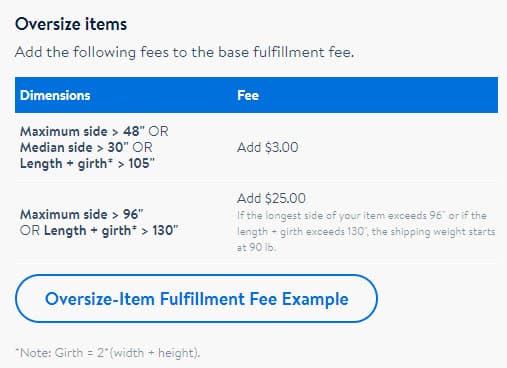
Your last option is to outsource fulfillment to one 3PL with national fulfillment services, or to multiple single-location 3PLs. The best 3PLs will have 10 or more locations across the United States, so they can strategically place your inventory in the perfect position for your customer base. Modern 3PLs designed for ecommerce also have built native integrations with all major marketplaces and shopping carts, so you can use one provider for all of your fulfillment needs. Fulfillment costs will vary between 3PLs, though, and not all of them can meet the strict SLAs needed to win the Buy Box on every marketplace. Be sure to use something like a 3PL request for proposal (RFP) template to get an apples to apples comparison.
Ship Heavy Items with the Right Carrier
Not every carrier is created equal when it comes to shipping heavy items, and relatively small adjustments in your package size and weight can have big implications when it comes to choosing the most cost-effective option.
FedEx’s guidelines on how to ship oversize items detail that they add an oversize shipping fee when packages have a girth of more than 130 inches. Note that if a package is over 150 lbs, or if its combined length and girth is more than 165 inches, then FedEx will classify it as freight and apply a completely different set of rules.
UPS governs its large items a bit differently. It will designate a package as “Over Maximum Size” when its length plus girth combined exceeds 165 inches, and charge additional fees. UPS charges additional fees for packages over 70 lbs and has a maximum package weight is 150 lbs.
Finally, USPS is less equipped to ship large packages, and thus has more restrictive rules. Their maximum size for most mailpieces is 108 inches in combined length and girth, but USPS Retail Ground has a slightly larger allowance of 130 inches. Regardless of size, the maximum mailable weight of any mailpiece sent through USPS is 70 lbs. Packages that are between 108 and 130 inches in combined length and girth are subject to a special oversized price on USPS.
These guidelines leave wiggle room for savvy merchants to optimize their shipping costs. Note that FedEx’s oversize charge only kicks in on packages with a girth of more than 130 inches, while UPS and USPS have lower limits. On top of that, the latter two’s limits are based on combined length and girth. If your package fits under FedEx’s bar for oversize, but over the bars for the other carriers, then you know that you can avoid surcharges by shipping with FedEx.
You can take it upon yourself to negotiate with the carriers separately, or if you’re using shipping software like ShipStation, you can set manual rules and rate shop to scrutinize your orders for the best rates. On the other hand, our next-gen shipping software will do the hard work for you by automatically comparing major and regional carriers against each other for each order. Without any manual intervention, the software will take quirks like differences in surcharges into account and ensure that you’re getting the best deal, every time.
Optimize Package Size
Small changes in package size can make a big difference to your final shipping cost. When you’re shipping large and oversize items, every additional pound usually adds $0.30 – $0.50 to your cost, which adds up quickly!
Package size matters because of Dimensional Weight, or DIM weight for short. Major carriers introduced DIM weight around 2015 as a way to charge more for bulky, yet light products. The calculation is fairly simple: DIM weight is equal to L x W x H of your package, divided by 139 (166 for USPS). If the resulting number is larger than the weight of the package in pounds, then the shipping weight used to calculate price will be elevated to the DIM weight.

In this way, inefficiencies in package design quickly add up to boost your shipping cost to well more than it should be.
Consider a package that is 24 x 24 x 24. This 2 ft cube package’s DIM weight is 99.45 lbs. If you’re shipping two pillows in that package, the actual weight is probably less than a tenth of the DIM weight. In that scenario, DIM weight increases your cost by $30 or more! What if you could shave 4 inches off one of the sizes by more efficiently compacting your pillows?
Those 4 simple inches cut the DIM weight all the way down to 82.88 lbs, a nearly 20% reduction. That package would fall into FBA’s “Medium oversize” category, with a shipping weight between 70 – 150 lbs. FBA’s fulfillment fee rises by $0.44 for each pound in that category, so shaving the 4 inches off of one side of the package would save you over $7 per order.
Cahoot Ships Heavy Items at Low Cost
Cahoot’s nationwide network of over a hundred warehouses provides affordable national ecommerce order fulfillment for ecommerce merchants.
We cover each of the three key pillars of reducing the shipping cost of heavy items for you:
- We’ll strategically distribute your inventory to 4+ locations
- Our next-gen shipping software automatically finds the lowest cost shipping label that meets your delivery SLA
- We work with you to shrink package size
Unlike other providers, Cahoot also has the flexibility to work alongside existing merchant-owned warehouses (if you have them). We know that many merchants with oversize goods carefully manage fulfillment themselves due to how difficult the process can be. Cahoot will analyze your existing network and customer base, then add a few locations of our own to seamlessly extend your network into a nationwide footprint.
With this approach, you can continue to get value out of your existing assets while delighting your customers and your bottom line with affordable fast shipping.
Getting started with Cahoot is fast and easy – with pre-built integrations for major ecommerce channels like Amazon, Walmart, Shopify, and BigCommerce, we can get merchants started in as little time as it takes to send us your inventory.
Talk to one of our experts today and explore how we can be the key that unlocks the next level of your profitable ecommerce growth.
Frequently Asked Questions
What is the cheapest way to ship heavy items?
This depends on the size of the item. For smaller items, USPS Priority Mail can be cost effective, and for larger items, UPS or FedEx is usually cheaper.
Are there any special instructions when shipping heavy items?
Heavy items can do more damage when moving in transit; proper packaging and dunnage help keep heavy items protected in shipping.

Turn Returns Into New Revenue

Why eCommerce Sellers Today Need Next-Generation Shipping Software
In this article
 8 minutes
8 minutes
- The Changing Landscape of Ecommerce Shipping
- How Next-Gen Shipping Software Simplifies Ecommerce Fulfillment
- Boosting Warehouse Efficiency with Automation
- Cutting Costs and Maximizing Profitability
- Conclusion: Next-Generation Software is Critical to Winning in the New World
- Frequently Asked Questions
Key Takeaways:
- Legacy shipping software is outdated and inefficient in today’s ecommerce world.
- Next‑gen shipping software automates fulfillment, reducing errors and improving delivery speed.
- Optimized order routing and packaging help businesses save money and maximize profitability.
- Warehouse automation boosts efficiency, helping businesses do more with fewer resources.
- Smarter carrier selection and real‑time rate shopping eliminate unnecessary shipping expenses.
Ecommerce logistics have evolved dramatically in the past two decades, and with this shift, the tools that businesses use must evolve too. Ecommerce shipping software is a powerful tool designed to streamline and automate the shipping processes for online businesses. Choosing the right ecommerce shipping solution significantly enhances operational efficiency and customer satisfaction. Legacy software, however, built for a simpler time, can no longer keep up with the growing complexities of modern ecommerce shipping, making it essential to choose the best shipping software for your business. Rising customer expectations, increasing competition, and skyrocketing operational costs have made traditional fulfillment strategies obsolete.
Enter next‑generation shipping software: a smarter, faster, and more cost‑effective solution designed to streamline operations, optimize shipping processes, and drive profitability. In this pillar article, we’ll explore the four key areas where next‑gen ecommerce shipping software is reshaping fulfillment and helping businesses thrive.
To help ecommerce merchants understand why traditional shipping software is no longer enough, we built a Next‑Generation Shipping Software Guide consisting of 4 parts to highlight what has changed between the old world and the new world, how next‑gen shipping software simplifies fulfillment operations, how it makes order fulfillment more efficient, and how it saves ecommerce businesses money:
- Ecommerce Shipping Challenges: The World Has Changed and Traditional Shipping Software is Not Enough
- Shipping Software for Ecommerce Fulfillment: The Next Generation of Shipping Simplified
- Next‑Gen Warehouse Automation Software for Ecommerce: Fulfillment Efficiency
- Save Money With Ecommerce Shipping Software: Next‑Gen Solutions
1. The Changing Landscape of Ecommerce Shipping
Two decades ago, ecommerce was a different world. Online Sellers operated on a single channel, faced minimal competition, and customers had lower expectations. Shipping was simple: businesses worked with a single carrier, operated from one warehouse, and didn’t have to worry about complex fulfillment logistics.
Fast forward to today, and the ecommerce landscape has changed dramatically:
- Sellers operate across multiple channels like Amazon, Walmart, and Shopify.
- Competition is intense, requiring fast, free shipping to stay ahead.
- Customers expect 1‑2 day delivery, forcing Sellers to distribute inventory across multiple warehouses.
- Carrier rate increases (GRIs) have made it more expensive to ship orders profitably.
With this growing complexity, businesses can no longer rely on legacy shipping software that lacks automation, intelligent decision‑making, and scalability. Next‑gen ecommerce shipping software is purpose‑built for today’s challenges, offering automated order routing, real‑time carrier rate shopping, and seamless multi‑channel integration to optimize fulfillment workflows.
2. How Next‑Gen Shipping Software Simplifies Ecommerce Fulfillment
Modern ecommerce fulfillment is no longer just about printing shipping labels; it’s about optimizing every aspect of the supply chain. Multi‑carrier shipping software allows businesses to compare rates and select the best carrier for each shipment, optimizing delivery times and reducing costs. Next‑gen shipping software simplifies fulfillment in three key ways:
Automated Order Routing & Carrier Selection
Traditional shipping software relies on manual rule‑setting, requiring Sellers to configure automation workflows manually. This process is prone to errors and inefficiencies. Next‑gen shipping software, like Cahoot, automates order routing by:
- Analyzing warehouse locations, inventory levels, and carrier options to pick the best fulfillment center.
- Selecting the most cost‑effective shipping label in real time.
- Minimizing errors and eliminating manual decision‑making through intelligent automation.
Seamless Multi‑Warehouse and Multi‑Channel Fulfillment
Today’s ecommerce businesses must operate across multiple fulfillment centers while managing orders from different marketplaces. Legacy shipping tools struggle to coordinate fulfillment effectively. Next‑gen solutions:
- Sync orders from multiple sales channels (Amazon, Walmart, Shopify, etc.) automatically.
- Ensure inventory is updated in real time to prevent overselling.
- Provide centralized tracking so businesses and customers stay informed on shipment status.
Optimized Packaging for Cost Reduction
Shipping costs are a major concern, and incorrect packaging can lead to excessive dimensional weight fees. Next‑gen software optimizes packaging by:
- Using AI‑powered cartonization to select the smallest possible box.
- Minimizing wasted space to reduce shipping costs.
- Automating packing decisions, eliminating the need for warehouse workers to make manual judgments.
- Automating international shipping processes, such as customs documentation and tax calculations, to prevent costly re‑work.
3. Boosting Warehouse Efficiency with Automation
Labor shortages and rising wages make it difficult for ecommerce businesses to scale using traditional warehouse management strategies. Next‑gen shipping software maximizes efficiency by reducing the need for manual intervention:
Reducing Manual Labor
Legacy software often requires warehouse staff to manually verify orders, select boxes, and compare carrier rates. With next‑gen software:
- Workers spend less time on repetitive tasks, reducing operational costs.
- Shipping label generation is fully automated, cutting down processing time from hours to minutes.
- Seasonal and part‑time staff can quickly onboard without extensive training, thanks to intuitive, easy‑to‑use interfaces.
Real‑Time Fulfillment Network Optimization
Unexpected delays such as warehouse disruptions, weather‑related shipping slowdowns, or inventory shortages can impact fulfillment speed. Next‑gen software helps businesses adapt in real time by:
- Identifying the best alternative fulfillment center if one location is affected.
- Re‑routing orders automatically to ensure deliveries remain on schedule.
- Reducing fulfillment downtime, keeping customers happy and operations running smoothly.
- Real‑time inventory tracking to prevent overselling and stockouts.
4. Cutting Costs and Maximizing Profitability
Ecommerce margins are tighter than ever, and reducing costs is critical to long‑term success. Next‑gen shipping software saves businesses money in three crucial ways:
Lowering Discounted Shipping Rates with Intelligent Rate Shopping
Traditional software requires businesses to set up static rules, but these don’t always result in the cheapest shipping label. By leveraging advanced algorithms, businesses can secure the best shipping rate for each order, further reducing costs. Next‑gen solutions:
- Compare carrier rates in real time, ensuring Sellers get the best deal.
- Automatically adjust shipping selections based on weight, dimensions, and distance.
- Reduce the risk of overpaying for shipping fees with dynamic optimization.
Avoiding Hidden Fees and Cost Leakages
Many businesses unknowingly lose money due to inefficient fulfillment processes. Next‑gen shipping software prevents cost leakages by:
- Eliminating unnecessary shipping surcharges through optimized package selection.
- Preventing human errors in box selection, reducing dimensional weight overcharges.
- Enhancing inventory tracking and distribution, ensuring products are stored in locations that minimize shipping costs.
- Effective inventory management ensures that products are stored in optimal locations, minimizing shipping costs and reducing the risk of overstocking.
Enabling Businesses to Do More with Fewer Resources
By automating labor-intensive tasks, businesses can reduce staffing needs and reallocate resources toward growth-driven initiatives. The benefits include:
- No need for dedicated shipping software teams to configure and maintain automation rules.
- Faster processing speeds, allowing businesses to handle more orders with the same workforce.
- Improved scalability, making it easier to expand operations without increasing costs.
Why Next‑Gen Shipping Software is a Game Changer
Ecommerce has evolved, and fulfillment operations must evolve with it. Legacy shipping software was designed for a different era; one with fewer channels, lower customer expectations, and simpler logistics. The modern landscape requires automation, intelligence, and flexibility to keep up with demand while staying cost‑effective.
Conclusion: Next‑Generation Software is Critical to Winning in the New World
We believe everything has changed in ecommerce. Amazon Prime has changed the industry in a manner comparable to how the iPhone changed society’s experience with, and access to, technology.
Prime transformed one aspect of ecommerce more than any other: shipping. However, this is the area where the least technological advancement has occurred. Legacy tools are costing Sellers time, money, and productivity on every order. In a world of competitive online marketplaces, sky‑high customer expectations, and rising costs, Sellers need software that helps them compete and win.
The future of ecommerce fulfillment is here, powered by next‑generation shipping software. By adopting these advanced solutions, businesses can streamline operations, improve customer satisfaction, and increase their bottom line. Such a tool must address key challenges of today—simplifying operational complexity, freeing up resources, and restoring margins in a competitive environment.
We believe this tool can provide you with strategic and competitive advantages in today’s complex ecommerce industry. Are you ready to make the switch? If you’d like to learn more, check out our Next‑Generation Shipping Software Guide, Part 1: “Ecommerce Shipping Challenges: The World Has Changed and Traditional Shipping Software is Not Enough.”
Frequently Asked Questions
How can I reduce shipping costs for my ecommerce business?
Reducing shipping costs requires a multi‑faceted approach:
- Negotiate rates with multiple carriers rather than relying on a single provider.
- Consider using regional carriers for deliveries within specific areas.
- Optimize packaging to reduce dimensional weight charges.
- Implement zone skipping by shipping bulk orders to carrier hubs closer to final destinations.
- Use shipping software that compares rates across carriers in real time.
- Offer local pickup options for customers in your area.
- Consider flat‑rate shipping for certain product categories.
- Learn more
Who uses shipping software?
Shipping software has features that can benefit various clients, including individual Sellers, ecommerce brands, retailers, and courier service providers. Feature‑rich software like Cahoot makes intelligent and scalable fulfillment accessible to businesses of all sizes.
What is fulfillment optimization?
Fulfillment optimization is the process of determining the best options for sourcing and order fulfillment, resulting in more efficient use of inventory and reduced costs.
How does warehouse automation software improve ecommerce fulfillment?
Warehouse automation software streamlines fulfillment by automating tasks such as order routing, shipping label generation, and inventory tracking. This reduces manual errors, increases processing speed, and optimizes carrier selection, ensuring faster and more cost-effective deliveries.
How does automated cartonization help reduce shipping costs?
Automated cartonization uses AI to determine the best packaging size for each order, reducing dimensional weight costs and preventing wasted space. This optimization leads to lower shipping fees and improved warehouse space utilization.

Turn Returns Into New Revenue

Major Carrier Peak Shipping Surcharges – 2023
In this article
 9 minutes
9 minutes
- Amazon FBA Peak Surcharges 2022
- USPS Peak Surcharges 2022
- Priority Mail and Priority Mail Express Rate Adjustments:
- First-Class Package Service, Parcel Select Ground, and USPS Retail Ground:
- FedEx Peak Surcharges 2022
- UPS Peak Surcharges 2022
- Reduce Shipping Costs with Cahoot Distributed Order Fulfillment
While each of Amazon, USPS, FedEx, and UPS are implementing peak surcharges for parcel delivery this holiday season, they’re all going about it in different ways.
Amazon, relatively new to the surcharge game, has added flat percentage fee increases to key services throughout the year. For peak, though, they have a sliding scale that will predictably hit bigger packages with bigger cost increases. Their peak surcharge will be added on top of the existing fuel and inflation surcharge they put into effect this summer, further squeezing seller margins.
Similar to Amazon, USPS will be using a sliding scale that increases the surcharge based on the parcel’s weight and zone. Flat Rate Boxes and Envelopes will see big jumps of $0.75 to $0.95, which will pinch the sellers that rely on these shipping options to keep their logistics costs down while selling inexpensive items.
FedEx, on the other hand, has more flat fees to add as surcharges, including a $2.50 per Ground Economy package charge during Black Friday and Cyber Monday. On top of that, they’ve introduced a “peaking factor” calculation to apply to their largest shippers. The more large shippers outstrip their summer volumes during peak, the more they’ll pay per package.
Like FedEx, UPS will use a dynamic pricing scale that will charge large shippers more when they far outstrip their summer volumes. Unlike FedEx (and the others), though, UPS won’t add a flat surcharge to all packages.
Let’s get into the details.
Amazon FBA Peak Surcharges 2022
On August 16th, Amazon announced that for the first time ever, they will implement a Holiday Peak Fulfillment Fee to take effect from October 15th, 2022 to January 14th, 2023. Per Amazon, The fee will be an average of USD $0.35 per item sold using US and Canada FBA.” Even in isolation, a 35 cent increase in order fulfillment fees can be difficult for sellers to absorb. Considering the enormous pressure that inflation is already putting on sellers and other FBA price increases, this could be the straw that breaks the camel’s back.
At an average of another 35 cents on top of the other increases, there are few, if any, items that haven’t shot up over a dollar in cost to fulfill through FBA this year. When you consider that many smaller items only cost $3 or $4 to fulfill through FBA, that’s a staggering 25%+ increase in one of the most important operational costs in one year. Sellers with small, $10 items have now likely seen over 10% more of their revenue disappear in FBA fees in just over half a year.
To add to FBA seller woes, storage costs for FBA will nearly triple from $0.83 to $2.40 per cb. ft. While this has long been Amazon’s policy and thus is expected, it doesn’t hurt margins any less.
USPS Peak Surcharges 2022
USPS announced their rate adjustments for the 2022 peak holiday season on August 10th, covering both commercial and retail parcels in most classes: Priority Mail Express, Priority Mail, First-Class Package Service, Parcel Select, and USPS Retail Ground. The surcharges are set to go into effect on October 2nd, 2022, and to last until January 22nd, 2023.
There are some notably large increases in prices among the surcharges – for instance, Commercial Priority Mail and Priority Mail Express Flat Rate Boxes and Envelopes will rise by $0.75 each, while their Retail counterparts will increase by $0.95 each. Here’s a full list of increases for their most popular services:
Priority Mail and Priority Mail Express Rate Adjustments:
- Commercial:
- $0.75 increase for PM and PME Flat Rate Boxes and Envelopes.
- $0.25 increase for Zones 1-4, 0-10 lbs.
- $0.80 increase for Zones 5-9, 0-10 lbs.
- $0.75 increase for Zones 1-4, 11-25 lbs.
- $2.80 increase for Zones 5-9, 11-25 lbs.
- $3.00 increase for Zones 1-4, 26-70 lbs.
- $6.50 increase for Zones 5-9, 26-70 lbs.
- Retail:
- $0.95 increase for PM and PME Flat Rate Boxes and Envelopes.
- $0.30 increase for Zones 1-4, 0-10 lbs.
- $1.00 increase for Zones 5-9, 0-10 lbs.
- $0.95 increase for Zones 1-4, 11-25 lbs.
- $3.20 increase for Zones 5-9, 11-25 lbs.
- $3.25 increase for Zones 1-4, 26-70 lbs.
- $6.45 increase for Zones 5-9, 26-70 lbs.
First-Class Package Service, Parcel Select Ground, and USPS Retail Ground:
- Commercial:
- $0.25 increase for Zones 1-4, 0-10 lbs.
- $0.40 increase for Zones 5-9, 0-10 lbs.
- $0.75 increase for Zones 1-4, 11-25 lbs.
- $1.60 increase for Zones 5-9, 11-25 lbs.
- $3.00 increase for Zones 1-4, 26-70 lbs.
- $5.50 increase for Zones 5-9, 26-70 lbs.
- Retail:
- $0.30 increase for Zones 1-4, 0-10 lbs.
- $0.60 increase for Zones 5-9, 0-10 lbs.
- $0.95 increase for Zones 1-4, 11-25 lbs.
- $2.70 increase for Zones 5-9, 11-25 lbs.
- $3.25 increase for Zones 1-4, 26-70 lbs.
- $5.85 increase for Zones 5-9, 26-70 lbs.
FedEx Peak Surcharges 2022
Unlike USPS, FedEx’s peak surcharges will kick in much earlier, in September. They are taking a much more granular approach to surcharges and fees that split out many different ways in which they’ll increase cost, and those cost increases will vary based on the particular date in peak. Not only will they vary by the particular date, but they’ll also vary by a new “peaking factor” that FedEx will use to dynamically charge more to the sellers that have the biggest spikes in sales. The better you do, the worse your margin will become.

Source: FedEx.com
FedEx’s basic surcharges will start with an additional $1.50 per package for Ground Economy services, in effect during November and from mid-December to mid-January. During the most busy time of Black Friday and Cyber Monday, that surcharge will jump up to an even higher $2.50 per package.
The “peaking factor” charge will be added on top of that, and it will be in effect from October 31st to January 15th. Thankfully for SMBs, it will only apply to enterprise customers that ship more than 20,000 Ground Economy packages per week, but it’s important to keep an eye on for the future regardless. What starts as a limited surcharge often spreads to apply to more people in subsequent years. The peaking factor will be calculated based on the ratio of volume shipped during peak as compared to an average to volume shipped during the relatively sleepy summer weeks of June 6th, 2022 – July 3rd, 2022. A seller that doubles their volume during peak will pay an extra $2.50 per Ground package and an extra $3.50 per Express on top of the previously mentioned surcharges. Quadruple your volume, and you’ll pay an extra $6.00 for Ground and $7.00 for Express, eating heavily into your margin.
UPS Peak Surcharges 2022
Finally, UPS shared their plans for peak surcharges in their September 9th update. Compared to USPS and FedEx, their surcharges are limited in scope and will affect fewer sellers. They have a range of surcharges that cover most international shipments, while their domestic surcharges will operate largely in the same way that FedEx’s “peaking factor” will work.
It will only apply to sellers that have been billed for more than 20,000 packages during any week since October 2021, and the surcharge will vary based on the type of service and the extent to which the seller’s peak volume outstrips their “Baseline Volume”. The baseline volume will be calculated as the customer’s average weekly volume for June 2022.

Source: UPS
UPS’s surcharges come out at a very similar level to FedEx’s peaking surcharges – for instance, a seller that doubles their baseline volume and uses UPS Ground Residential will pay $2.50 more per package, while Next Day Air Residential will cost $3.50 extra per package. Those numbers are identical to those of FedEx, as are many of the other surcharges.
UPS’s international surcharges will add cost in a linear fashion based on package weight. For instance, international shipments from the US to Europe will cost $0.15 per lb more via UPS Worldwide Express Plus. Most of their international surcharges are going into effect on September 25th, and notably, they haven’t provided an end date to the rate increases.
Reduce Shipping Costs with Cahoot Distributed Order Fulfillment
Cahoot has created an Amazon-like ecommerce order fulfillment network that makes low cost, fast and free shipping a breeze for every eCommerce sales channel. We use our large number of warehouses to strategically stage merchant inventory in multiple locations close to their customers, which minimizes their Zone profile. This both saves on shipping costs and time, which expands margin for the sellers and delights customers with short delivery times.
Cahoot is the next generation of tech-enabled order fulfillment services networks. Unlike other networks that are collections of third party logistics warehouses, Cahoot’s innovative approach empowers merchants across the country to fulfill orders for one another. Our peer-to-peer network is a collective of highly vetted eCommerce retailers who offer up excess warehouse space and resources to provide high-quality order fulfillment to other merchants. Since they fulfill their own DTC orders, they know how important top-notch order fulfillment is, and they put the same care and energy into your orders as they do for their own.
With a peer-to-peer network, multi-channel fulfillment with nationwide 1-day and 2-day delivery at economy shipping rates is the norm.
Offer 1-day and 2-day shipping at ground rates or less.
Related Blog Posts

Packaging Design That Will Make Fulfillment Easy and Cut Costs
E-commerce Revolution with Strategic Packaging Solutions Like anyone in the e-commerce world, small business owners are always looking for ways to streamline their operations

UPS Announces Astonishing SurePost Rate Increases for 2025
UPS SurePost is a hybrid delivery service that integrates UPS’s network with USPS’s extended final-mile reach and capabilities. It’s a partnership between two competitors playing to each of their strengths to achieve greater cost efficiency, and it’s set to undergo notable changes in 2025.
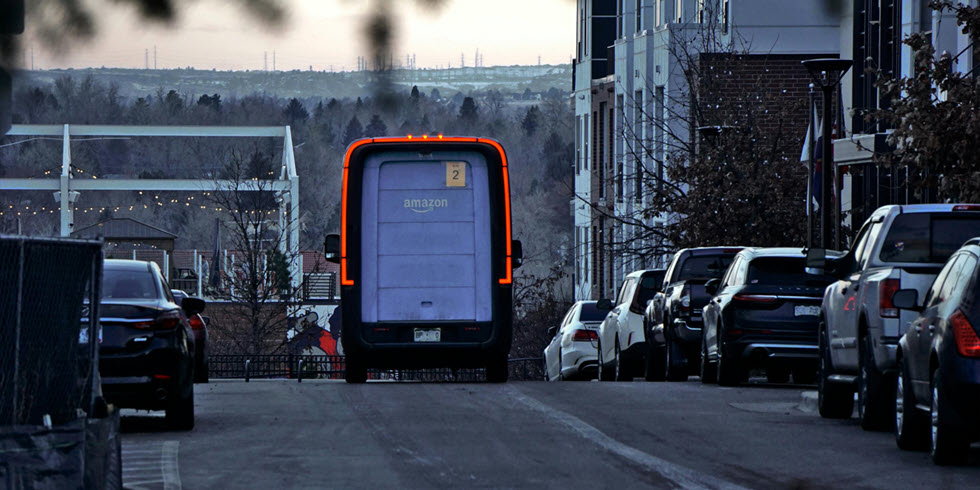
Amazon’s New Shipping & Delivery Policies, Key Changes and Their Implications
Amazon is rolling out significant changes to its shipping and delivery policies that will impact Sellers across the platform. These updates aim to enhance the customer experience by ensuring faster, more accurate delivery times while also providing tools and guidance for Sellers to meet these new standards.

Turn Returns Into New Revenue

Amazon Expands Free Shipping for ALL Orders to Non-Prime Members
In this article
Starting Monday and for an unspecified limited time, all Amazon customers — and not just Prime members — will get free shipping with no minimum purchase, which the e-commerce giant in a press release said will apply to “hundreds of millions of items.”
The news comes as rivals have also boosted their free delivery. Target last month, for example, announced free two-day shipping between Nov. 1 through Dec. 22 with no minimum purchase or membership required. And Walmart has expanded free two-day shipping (with a $35 minimum) to “millions of additional items” sold by third-party sellers on its online marketplace, and customers can return marketplace items to any Walmart store.
Offer 1-day and 2-day shipping at ground rates or less.
Related Blog Posts

Packaging Design That Will Make Fulfillment Easy and Cut Costs
E-commerce Revolution with Strategic Packaging Solutions Like anyone in the e-commerce world, small business owners are always looking for ways to streamline their operations and

USPS Hazmat Shipping Guidelines – How to Ship Fast While Staying Compliant
Hazardous Materials What is a Hazardous Material? What Items Are HAZMAT? Classes of HAZMAT Items What Classes Can Ship on Various USPS Services? What Changes

Protect Your Amazon Listings from Search Suppression, Hijackers, and Stockouts
Amazon is a competitive platform. You need to have a quality product, excellent listing content, and plenty of reviews to catch the attention of busy
USPS Hazmat Shipping Guidelines – How to Ship Fast While Staying Compliant
In this article
 24 minutes
24 minutes
- Understanding Hazardous Materials Regulations
- What is a Hazardous Material?
- What Items Are HAZMAT?
- Classes of HAZMAT Items
- What Classes Can Ship Using USPS Services?
- What Changes Have USPS Recently Made to Hazardous Materials Regulations?
- Why Have These Changes Been Made?
- What Should You and Your 3PL Do While Shipping HAZMAT?
- Declare HAZMAT During Label Generation
- Additional Resources and Support
- Conclusion
- Frequently Asked Questions
Understanding Hazardous Materials Regulations
Navigating the landscape of hazardous materials regulations is crucial for ensuring the safe and secure transportation of these potentially dangerous goods. These regulations are meticulously designed to prevent accidents, injuries, and environmental damage during the transportation process.
In the United States, the Department of Transportation (DOT) plays a pivotal role in regulating the transportation of hazardous materials. The DOT’s Hazardous Materials Regulations (HMR), found in Title 49 of the Code of Federal Regulations, outline comprehensive guidelines for the classification, packaging, and labeling of hazardous materials. These regulations ensure that hazardous materials are properly identified and handled with the utmost care.
The HMR mandates that hazardous materials must be accurately classified, appropriately packaged, and clearly labeled before transportation. Additionally, individuals involved in handling these materials are required to undergo proper training to adhere to established safety procedures. This training is essential for minimizing risks and ensuring compliance with regulatory standards.
Beyond the DOT, other regulatory bodies also contribute to the safe handling of hazardous materials. The Occupational Safety and Health Administration (OSHA) enforces regulations that govern the handling of hazardous materials in the workplace, ensuring the safety of employees. The Environmental Protection Agency (EPA) oversees the transportation of hazardous waste, further safeguarding public health and the environment.
By adhering to these regulations, individuals and organizations can significantly reduce the risk of accidents and injuries, while also protecting the environment. Compliance with hazardous materials regulations is not just a legal obligation but a critical component of responsible and safe transportation practices.
What is a Hazardous Material?
For many ecommerce brands and sellers, there are already lots to think about when shipping orders – you need to send inventory to warehouses, have shipping labels printed, and pick, pack and ship items correctly.
However, some sellers sell products that require extra diligence, care, and attention while shipping them. Shipping Hazardous Materials, or HAZMAT as they’re commonly called, can be complex. In January 2025, the United States Postal Service (USPS) announced a number of changes to the guidelines sellers have to follow while shipping HAZMAT items. Following these guidelines is important for sellers to maintain compliance and mitigate regulatory risks, while also ensuring the safety of USPS staff who ship and deliver your packages.
A lot of sellers may not be aware of the extent and impact of these new changes. Failing to comply with the new requirements can cause significant damage to your brand. In this article, we’ve compiled everything you need to know about HAZMAT shipping.
We start by understanding the definition of a hazardous material and what items are classified as HAZMAT. We then take a deep-dive into how the Postal Service was handling HAZMAT previously and what has changed in the latest requirements. We examine why the USPS might be making these changes and the potential penalties you face for non-compliance. Lastly, we look at what your fulfillment partner (3PL) must do to ship hazmat orders in a compliant manner, keeping your brand, USPS personnel, and your customers safe.
What Items Are HAZMAT?
The Postal Service classifies every hazardous material into one of nine categories.
Common hazardous materials that are regulated include:
- Combustible liquids
- Hazardous substances
- Lithium batteries
- Lithium ion batteries
- Hazardous waste
- Hazardous wastes
- Common hazardous materials
Proper packaging of hazardous materials packages is crucial to ensure compliance with safety standards and prevent leaks or spills during shipping.
Classes of HAZMAT Items
Let’s first examine these categories, understanding their definitions, example items that fall into them, and the risks they can pose to people, the environment, or property.
You can use this as a template to do a preliminary analysis of whether your items are likely to fall into any of these HAZMAT categories. Proper classification and packaging are essential for shipping dangerous goods safely and in compliance with regulations. Packages that do not meet HAZMAT regulations can be held and delayed, destroyed by the postal service, or result in fines.
Hazard Class |
Definition |
Example Items |
Risks |
|---|---|---|---|
1.1 – 1.6 |
Explosives with varying characteristics |
Fireworks, dynamite, and ammunition (small arms) |
Can vary from a massive explosion to low sensitivity explosions. |
2.1 |
Flammable Gasses |
Lighter fluid, Propane, and Butane |
Fire hazards and explosion risks |
2.2 |
Non-Flammable, Non-Toxic Gasses |
Nitrogen (for tires), Carbon Dioxide (fire extinguisher) |
No fire hazard, asphyxiation risk |
2.3 |
Toxic Gasses |
Household Cleaners (Ammonia), Bleach |
Toxic inhalation hazard |
3 |
Flammable Liquids |
Gasoline, Rubbing Alcohol, Lighter Fluid |
Fire hazard |
4.1 |
Flammable Solids |
Matches, Lighter Cubes, Firestarters |
Fire hazard, may contribute to combustion |
4.2 |
Spontaneously Combustible Solids |
Spontaneous Combustion Firestarters |
Can ignite spontaneously |
4.3 |
Dangerous When Wet |
Fertilizers (contains Ammonium Nitrate), Sodium (in water) |
Can release flammable gas when in contact |
5.1 |
Oxidizing Substances |
Hydrogen Peroxide (in hair bleach), Nitric Acid (in fertilizers) |
Enhances combustion, fire risk |
5.2 |
Organic Peroxides |
Acne Creams (Benzoyl Peroxide), Hair Bleaching Kits (contains peroxide) |
Fire and explosion risk |
6.1 |
Toxic Substances |
Pesticides (e.g., Insecticides), Household Cleaners (contains toxins) |
Toxic to humans |
6.2 |
Infectious Substances |
Medical Waste, Biological Cultures (e.g., from labs) |
Risk of spreading diseases |
7 |
Radioactive Materials |
Smoke Detectors (contains Americium), X-ray Machines (used in medical facilities) |
Ionizing radiation hazard |
8 |
Corrosive Substances |
Drain Cleaner (contains Sulfuric Acid), Alkaline Batteries |
Corrosive to materials, skin, eyes |
9 |
Miscellaneous Hazardous Materials |
Lithium Batteries (found in electronics), Asbestos-containing Materials |
Various hazards depending on the material |
What Classes Can Ship Using USPS Services?
Based on the class of item your product falls into, it may or may not be allowed on Ground or Air services in the US or International shipping.
You can use this as a resource to understand whether your item is allowed to ship, and what services it can be sent through.
Ensure that each package is labeled with the proper shipping identification to comply with USPS regulations.
Substantial portions of this chart are based on Publication 52 – Hazardous, Restricted and Perishable Mail from the USPS.
For more information on a specific hazard class or regulation, refer to Publication 52. For help with a specific SKU you’re trying to ship, refer to the Postal Service’s HAZMAT Shipping tool.
Items |
Ground |
Air |
International |
|---|---|---|---|
Explosives With Varying Characteristics (1.1 to 1.6) |
Prohibited Class 1.4 (Minor Explosion Hazard) may be shipped, only with prior approval from USPS Headquarters as per 341.2c of Publication 52 |
Prohibited |
Prohibited |
Flammable Gasses (2.1) |
Only as Limited Quantity Surface Material, per 342 of Publication 52 |
Prohibited |
Prohibited |
Non-Flammable, Non-Toxic Gasses (2.2) |
Only as Limited Quantity Surface Material, per 342 |
Permitted if material qualifies as ID8000, per 342 |
Prohibited |
Toxic Gasses (2.3) |
Prohibited |
Prohibited |
Prohibited |
Flammable Liquids (3) |
Only as Limited Quantity Surface Material, per 343 |
Prohibited Combustible liquids are permitted if material qualifies as ID8000 per 343 |
Prohibited |
Flammable Solids (4.1) |
Only as Limited Quantity Surface Material, per 344 |
Prohibited |
Prohibited |
Spontaneously Combustible Solids (4.2) |
Only as Limited Quantity Surface Material, per 344 |
Prohibited |
Prohibited |
Dangerous When Wet (4.3) |
Only as Limited Quantity Surface Material, per 344 |
Prohibited |
Prohibited |
Oxidizing Substances (5.1) |
Only as Limited Quantity Surface Material, per 345 |
Only as Limited Quantity Air Material, per 345 |
Prohibited |
Organic Peroxides (5.2) |
Only as Limited Quantity Surface Material, per 345 |
Only as Limited Quantity Air Material, per 345 |
Prohibited |
Toxic Substances (6.1) |
Only as Limited Quantity Surface material per 346. Other poisons may ship as permitted in 346.231 |
Permitted if it qualifies as ID8000 material per 346. Other poisons may ship as permitted in 346.231 |
Prohibited |
Infectious Substances (6.2) |
Only as permitted in 346 |
Only as permitted in 346 |
Only First-Class Package International Service with Registered Mail service per 622 |
Radioactive materials (7) |
Only per 347 |
Prohibited |
Only First-Class Package International Service with Registered Mail service per 622 |
Corrosive Substances (8) |
Only Limited Quantity Surface material per 348 |
Only Limited Quantity Air material per 348 |
Prohibited |
Miscellaneous Hazardous Materials (9) |
Only Limited Quantity Surface material and other materials as permitted in 349 |
ID8000 material and other materials as permitted in 349 |
Prohibited, except for magnetized materials per 349 and 622.4 and lithium batteries per 622.5 |
What Changes Have USPS Recently Made to Hazardous Materials Regulations?
Recently, the USPS has been making a number of changes to the way it handles and processes HAZMAT shipping.
These have important implications for sellers. In this section, we take a look at each of them:
Declaring HAZMAT During Label Generation
USPS now requires shippers to officially declare that packages contain HAZMAT when they purchase shipping labels.
The shipping label consequently clearly indicates this, making it easy for USPS staff to handle the shipment with the required care. Proper documentation is essential for transporting hazardous materials safely and in compliance with regulations.
Items Allowed on Ground vs. Air
Recently, USPS has begun restricting electronic devices that are used, damaged, or defective to ground services alone.
These packages must now be labeled as ‘Restrictive Electronic Devices’ for ‘Surface Transportation Only’.
Separation of HAZMAT And Non-HAZMAT Items
The USPS has also begun requiring that HAZMAT and non-HAZMAT items must be clearly separated into different parcels or mail receptacles. The HAZMAT parcels need to have clear marking and identification.
Why Have These Changes Been Made?
Why is there suddenly an increased focus on these compliance requirements from the Postal Service? Many shippers have been used to operating without any changes to requirements for a long time and might be surprised about why these changes are taking place now.
In this section, we’ll take a look at why USPS is enforcing these new requirements, as well as the risks you face if you don’t comply with them.
Safety of USPS Personnel and Transportation

According to Shippo’s estimates, over 10,000 safety incidents involving HAZMAT shipping were reported in the first nine months of the 2020 fiscal year. That number has continued rising – in 2022, there were over 25,000 HAZMAT incidents reported.
Such incidents pose significant risks for USPS personnel, the environment, property, and other people sharing the road or airspace during their transportation. In a bid to reduce this impact and improve overall safety outcomes, these new requirements are being enforced.
More Reliable On-Time Delivery
While these incidents are detrimental from a health and safety perspective, that isn’t their only negative. They disrupt operations and delay deliveries. In fact, Shippo estimates that packages are delayed by an average of 2 weeks after such incidents.
With USPS aiming to compete more aggressively in parcel delivery with the likes of UPS and FedEx, an increasing accident rate can lower their delivery SLAs and affect service levels for all shippers.
USPS’ latest regulations are aimed at streamlining their network operations and reducing downtime and disruptions.
Penalties For Non-Compliance
As the number of HAZMAT shipping related incidents is on the rise, failure to comply could affect your brand’s ability to conduct operations normally. With health, safety, and lives at stake – the penalties for noncompliance are heavy. Here are the possible penalties:
- Your shipments could be denied entry into the USPS mailstream – affecting your ability to meet customer delivery promises.
- For serious infractions, the US Department of Transportation can pursue civil penalties.
- The maximum penalty for Hazardous Materials violation is $89,678. However, if the violation results in death, serious illness, severe injury to an individual or significant damage to property, you could be fined as much as $209,249.
Such incidents can be financially damaging, affect your brand’s reputation and in some cases even threaten its very existence.
What Should You and Your 3PL Do While Shipping HAZMAT?
The first question you might have is – which of my SKUs are HAZMAT? The quickest way to identify this is using the Product Safety Data Sheet (SDS). What is a Safety Data Sheet?
Identify Your HAZMAT SKUs Using Product Safety Data Sheets (SDS)
A Safety Data Sheet (SDS) is a document that provides detailed information about the properties, hazards, and safe handling procedures of a product. It includes essential details such as the product’s composition, physical and chemical characteristics, potential health and environmental hazards, safe usage guidelines, emergency response measures, and regulatory information.
You can use the SDS database to locate your product’s safety sheet.
On it, you’ll need to go to Section 14, which provides transportation information, including the category that DOT classifies the product under. Using this, you can understand which USPS services can be used to ship the item, as well as specific marking/labeling, and packaging requirements.
Properly Designate HAZMAT SKUs on Shipping Software
You need to designate your HAZMAT SKUs on your shipping software. This is important for a number of reasons:
- This can be transmitted to USPS when purchasing labels, so that they know you are shipping HAZMAT.
- It helps your fulfillment partner affix the right marking/labels when packing these items.
- It helps your fulfillment partner package these items the right way.
Having your SKUs properly designated on a digital system of record is the best way to ensure defect-free, compliant fulfillment. Relying on spreadsheets or human-to-human conversation can lead to potentially costly lapses.
Adhere to Packaging Requirements
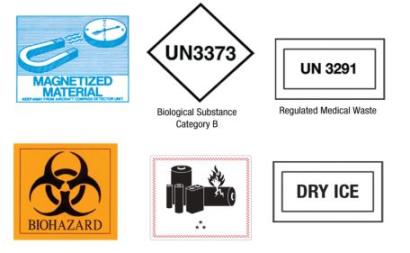
While shipping HAZMAT, you must make sure to follow packaging requirements to keep your items secure and spill or leak-proof.
Your fulfillment partner must have deep knowledge of what HAZMAT SKUs you are shipping, and then package them in accordance with the specific requirements laid out in Appendix C of Publication 52.
While the details can vary significantly based on the item, these are broad best-practice guidelines applicable across most items. Following these packaging practices requires industry-leading fulfillment standards from your 3PL. Warehouse staff must make sure to diligently pack each SKU in the best possible way on every order.
Inner Packaging
- Employ inner packaging that is compatible with the specific hazardous material but also capable of withstanding the conditions of transportation.
- Inner packaging must be leak-tight for liquids and gas-tight for gasses, preventing unintended release during transit.
Outer Packaging
- Utilize robust outer packaging that serves as a primary barrier to protect the inner packaging and the contents from external forces and potential hazards.
- All HAZMAT and Dangerous Goods need to ship in rigid outer packaging that meets minimum edge crust test (ECT) requirements:
- Packages weighing 20 lbs or less: ECT of at least 32, burst strength of 200 lbs.
- Packages weighing more than 20 lbs: ECT of at least 44, burst strength of 275 lbs.
- Choose outer packaging materials that are suitable for the specific characteristics of the hazardous material being shipped.
Cushioning and Absorption
- An effective cushioning system safeguards the inner packaging from movement and potential damage during transit, providing an additional layer of protection.
- For liquids, incorporate absorbent materials within the packaging to contain and manage spills, preventing leakage that could pose safety and environmental risks.
Closure and Sealing
- Ensure secure closure and sealing of packages to prevent any leakage or spillage during transportation.
- Verify that closures meet regulatory standards and are appropriate for the specific hazardous material being shipped, maintaining the integrity of the package.
Overpack Requirements
- If applicable, employ overpacking techniques as an additional layer of protection and consolidation for smaller packages.
- Overpacks should not only consolidate packages but also be designed to contain leaks or spills, providing an extra measure of safety.
Separation of HAZMAT
- Package hazardous materials with a keen focus on preventing any reactions between different substances within the package.
- Separation of incompatible materials within the packaging ensures that any potential chemical reactions are avoided, maintaining the safety and stability of the shipment.
Quantity Limits
- Adhere strictly to quantity limits specified for each hazardous material to prevent overloading and ensure compliance with safety regulations.
- Packaging must be designed to accommodate the specified quantity, preventing any compromise in the safety of the contents.
Adhere to Marking and Labeling Requirements
When shipping HAZMAT items, it is important to affix various marking labels onto the package that provide information to USPS staff about what the package contains.
This helps them handle the package the right way and ensures higher safety standards. While these can vary significantly by product, here are a few common marking/labeling practices required for HAZMAT items. For your specific SKU, make sure to refer to Appendix C of Publication 52.
Your 3PL must be capable of mapping each SKU you have to its specific labeling requirements. This detail-oriented rigor must be backed up by defect-free, high-quality fulfillment standards that ensure each package has all the necessary labels on it.
- Hazard Class Labels
- Hazard class labels need to be affixed to the outer packaging, indicating the primary hazard class or division of the material.
- Ensure hazard class labels are prominently displayed, providing USPS staff a quick visual identification of the potential risks associated with the shipment.
- Handling Labels
- Mark packages with handling labels, communicating specific instructions on how to safely handle them during transportation.
- Clear and concise handling labels contribute to the safe and proper management of the package during transit.
- Identification Numbers
- Clearly display proper shipping names and identification numbers on the outer packaging.
- This information assists in identifying the material and its associated hazards, aiding in emergency response and handling procedures.
- Limited Quantity Marking
- If applicable, mark packages with the “Limited Quantity” marking to indicate compliance with quantity limitations for certain hazardous materials.
- This marking is crucial for packages that qualify for reduced regulatory requirements.
- Overpack Marking
- For overpacks, mark them appropriately to indicate that they contain hazardous materials.
- Overpack markings help handlers and emergency responders quickly identify packages that include multiple smaller packages.
- Orientation Arrows
- On packages containing liquids, include orientation arrows to indicate the correct orientation for safe handling.
- Proper orientation ensures that liquids are transported in a manner that minimizes the risk of leaks or spills.
- Elevated Temperature Marking
- If applicable, mark packages containing materials at elevated temperatures to communicate the additional risks associated with heat.
- This marking ensures awareness of temperature-related hazards during transportation.
Declare HAZMAT During Label Generation
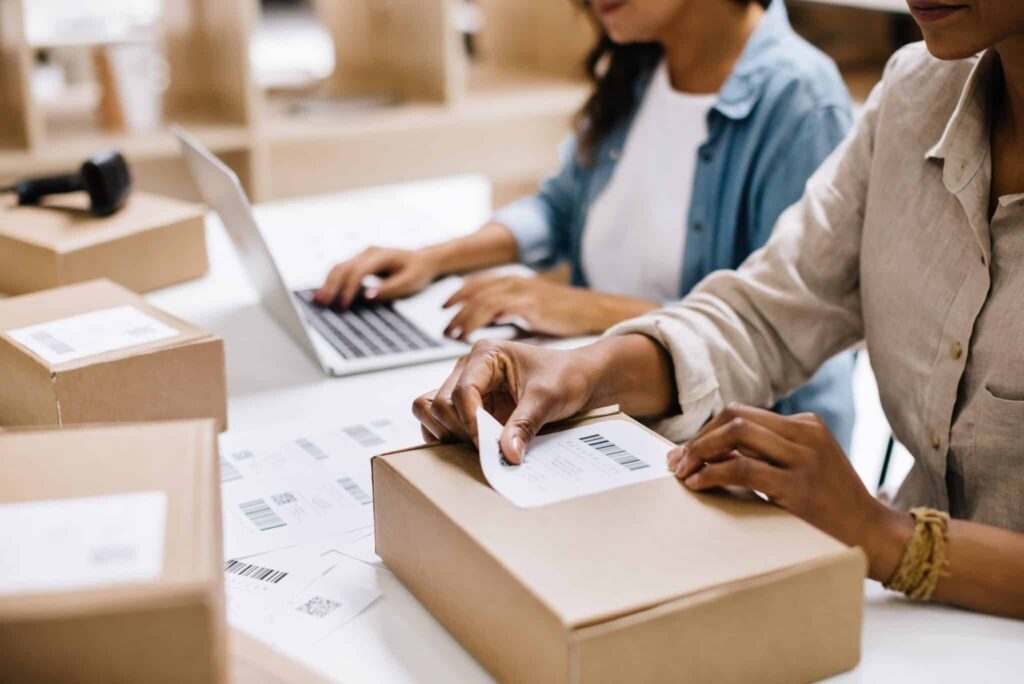
If you’ve designated your SKUs as HAZMAT in your shipping software, this step shouldn’t be too difficult!
When generating labels, your shipping software needs to inform USPS that you’re shipping HAZMAT. This allows the Postal Service to prepare to handle your items the right way.
Additional Resources and Support
Ensuring compliance with hazardous materials regulations can be a complex task, but fortunately, there are numerous resources available to assist individuals and organizations. These resources provide valuable information, guidelines, and support to help navigate the regulatory landscape effectively.
Key resources include:
- Department of Transportation’s (DOT) Hazardous Materials Regulations (HMR): The primary source for regulations governing the transportation of hazardous materials.
- Occupational Safety and Health Administration’s (OSHA) Hazardous Materials Regulations: Guidelines for handling hazardous materials in the workplace.
- Environmental Protection Agency’s (EPA) Hazardous Waste Regulations: Regulations specifically focused on the transportation of hazardous waste.
- International Air Transport Association’s (IATA) Dangerous Goods Regulations: Guidelines for the safe transportation of dangerous goods by air.
- International Maritime Organization’s (IMO) Dangerous Goods Regulations: Regulations for the safe transportation of dangerous goods by sea.
- Federal Regulations Hazardous Materials Table: A comprehensive resource providing information on the classification, packaging, and labeling of hazardous materials.
- Safety Data Sheet (SDS): Detailed documents for a SKU that provide information on the safe handling and use of hazardous materials. Obtained from the manufacturer.
- Material Safety Data Sheet (MSDS): Similar to SDS, these sheets offer information on the safe handling and use of hazardous materials. Obtained from the manufacturer.
- Hazardous Materials Information Center: A resource center providing information and support on hazardous materials regulations and safety procedures.
- National Institute for Occupational Safety and Health (NIOSH): Offers information and resources on workplace safety and health, including hazardous materials safety.
- American Society of Safety Professionals (ASSP): Provides resources on workplace safety and health, including hazardous materials safety.
In addition to these resources, various organizations and companies offer training and consulting services to help ensure compliance with hazardous materials regulations. These services are invaluable for individuals and organizations looking to enhance their understanding of regulatory requirements and implement effective safety procedures.
Staying up to date with the latest regulations and utilizing available resources is essential for maintaining compliance and ensuring the safe transportation of hazardous materials. By leveraging these resources, individuals and organizations can effectively manage the complexities of hazardous materials regulations and contribute to a safer transportation environment.
Conclusion
With an increased focus on the safety of its personnel and the performance of its network, USPS has rolled out these new HAZMAT changes.
Many, many items fall under HAZMAT, and a lot of them may not be immediately obvious as meeting the classification. With increased penalties and regulations, it is important for shippers to carefully scan their product catalog for HAZMAT SKUs and then ship them following all necessary protocols.
This takes deep attention to detail, high quality fulfillment standards, and solid technology at your fulfillment partner’s end. Shipping HAZMAT items can seem daunting – but with the right fulfillment partner, you’ll be able to ship them as seamlessly as your other SKUs. Good luck, and happy shipping!
Frequently Asked Questions
What are the Risks of Not Shipping HAZMAT Correctly?
Improperly labeled packages can be delayed or destroyed by the post office. Your business may also be fined for violations, and penalties up to $209,249.00 can occur if the HAZMAT violation results in death, serious injury or property destruction.
Do HAZMAT Rules Apply to All Shipping Carriers?
Each shipping carrier has its own rules and regulations for shipping HAZMAT goods. USPS rules and regulations do not apply to UPS or FedEx.
How Can I Tell if an Item is Considered HAZMAT?
Always make sure! Check the product’s Safety Data Sheet (SDS) from the manufacturer or use a HAZMAT search tool.

Turn Returns Into New Revenue


